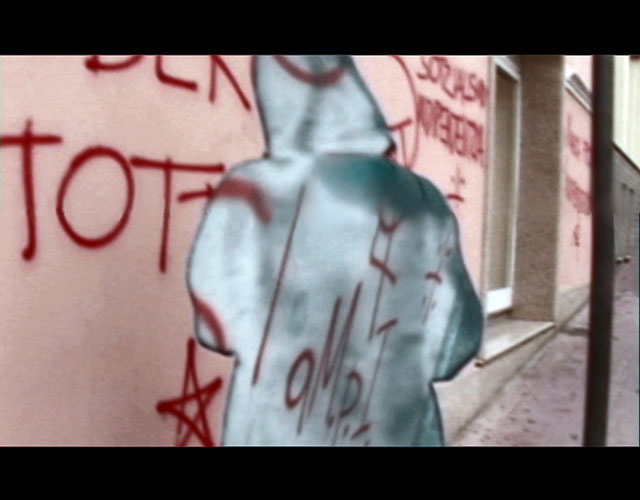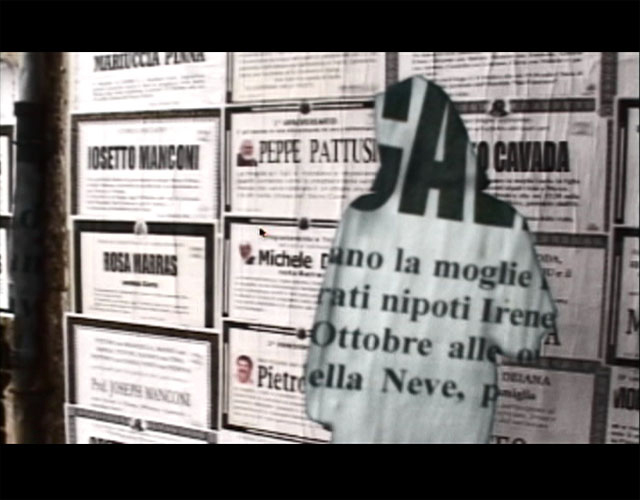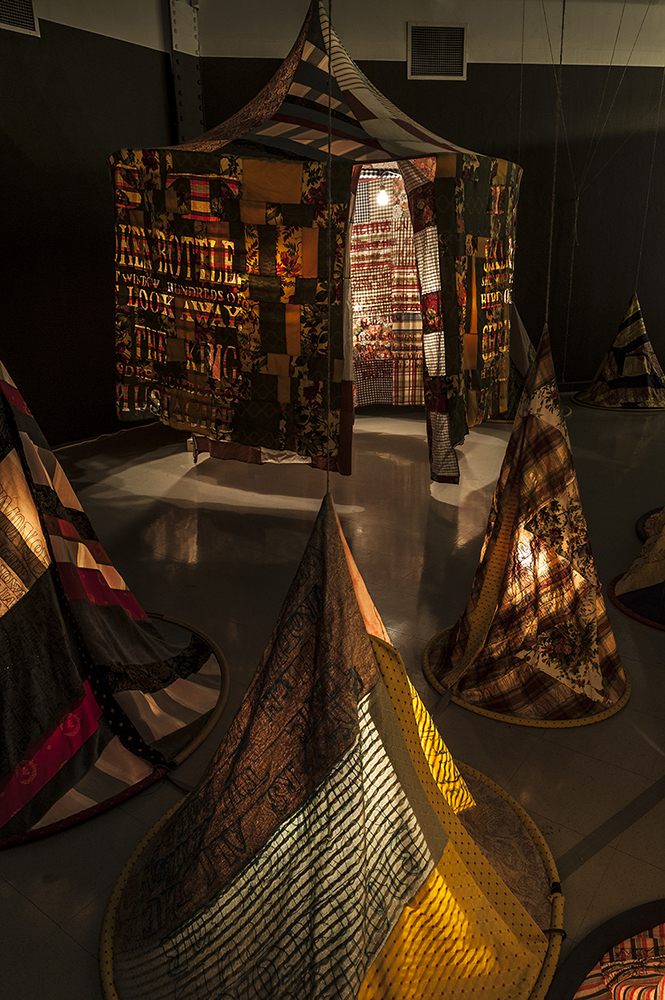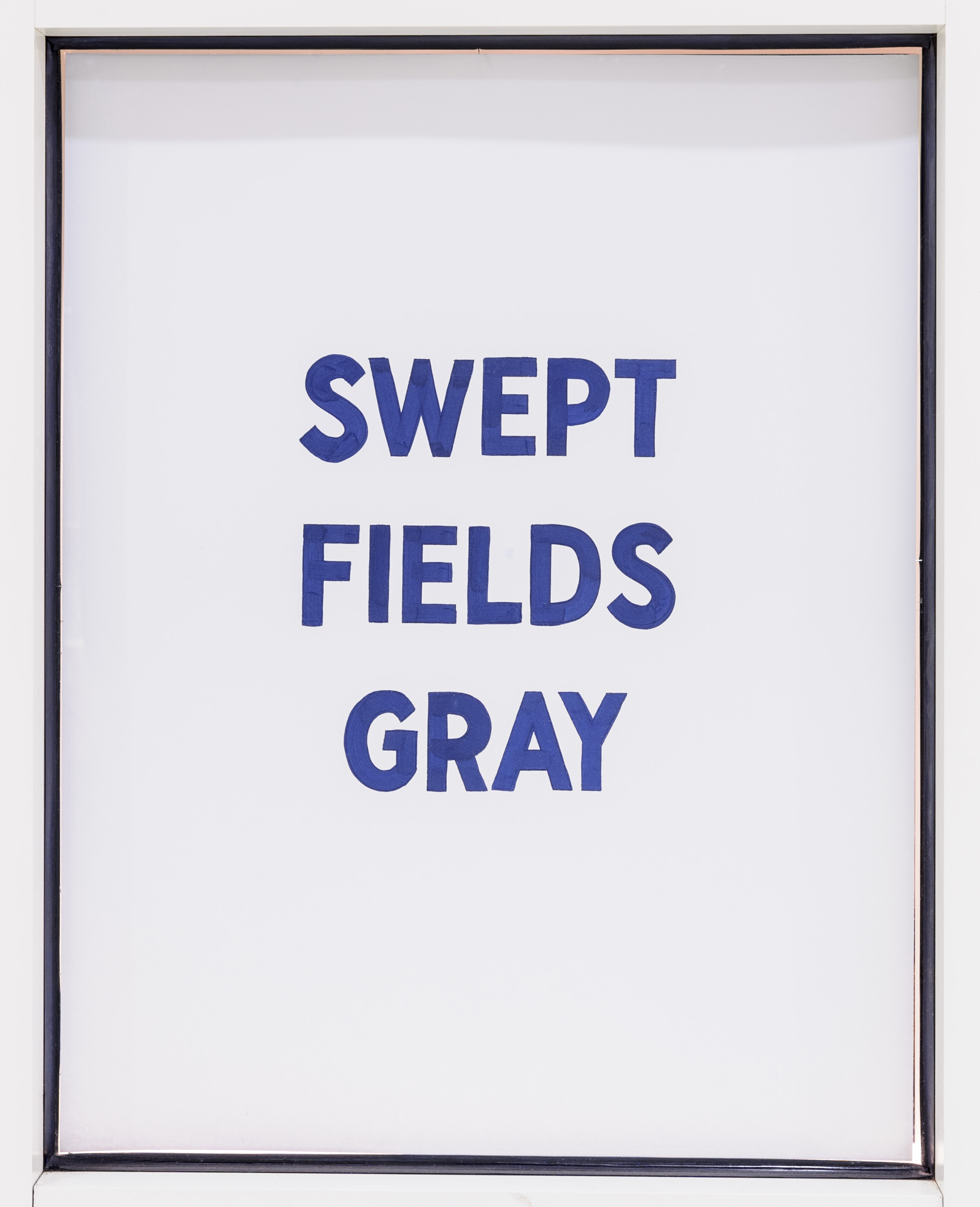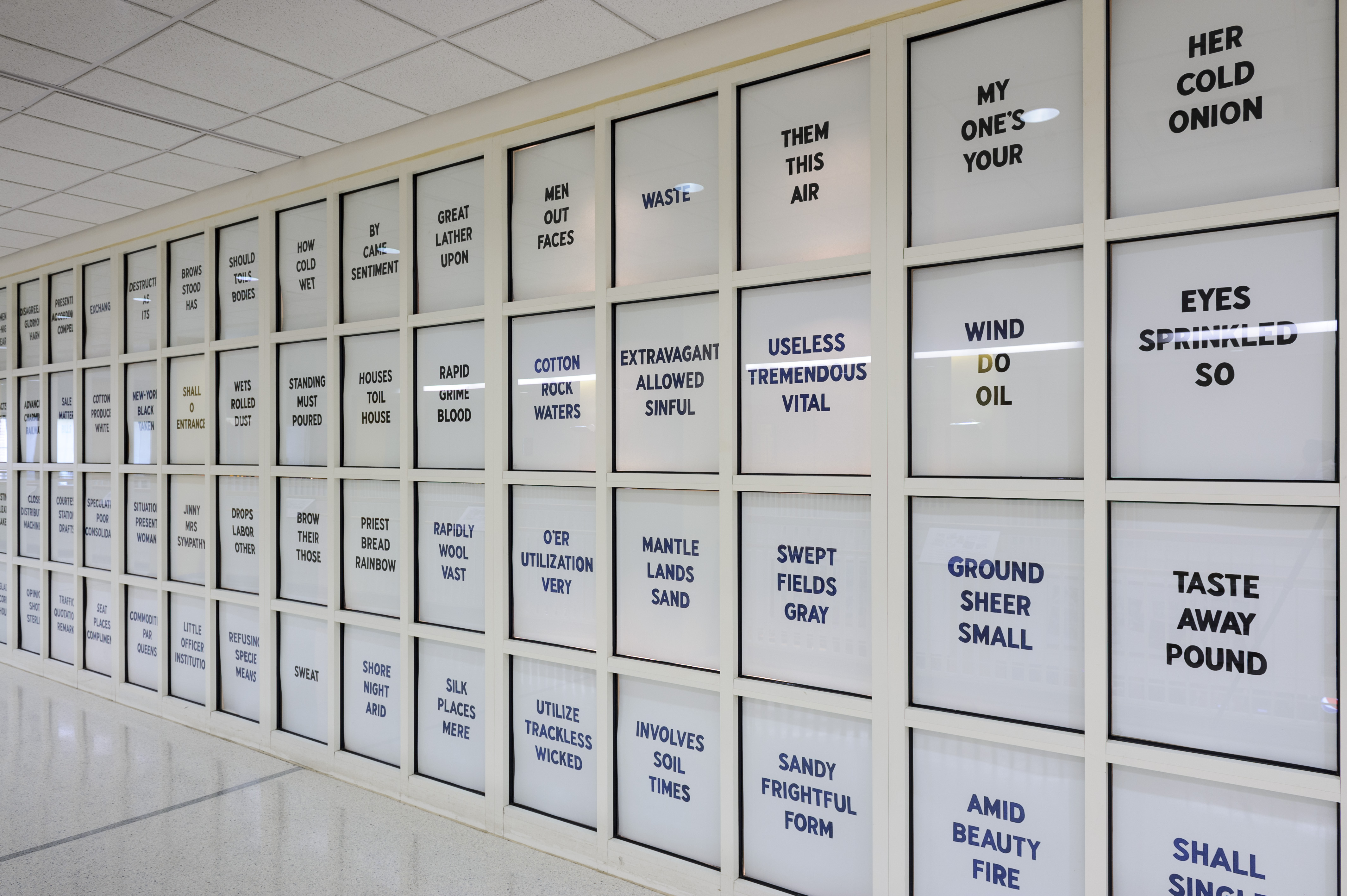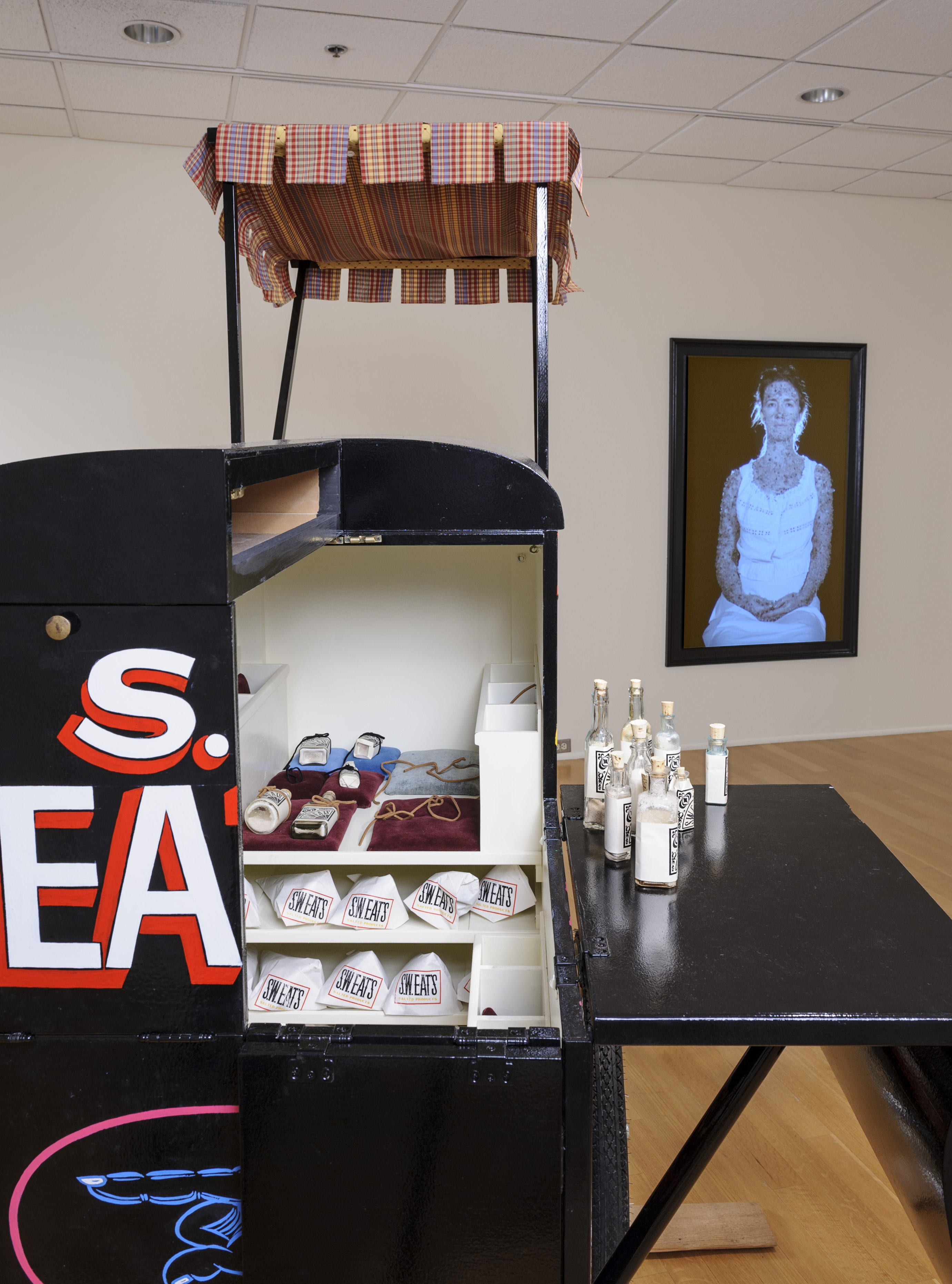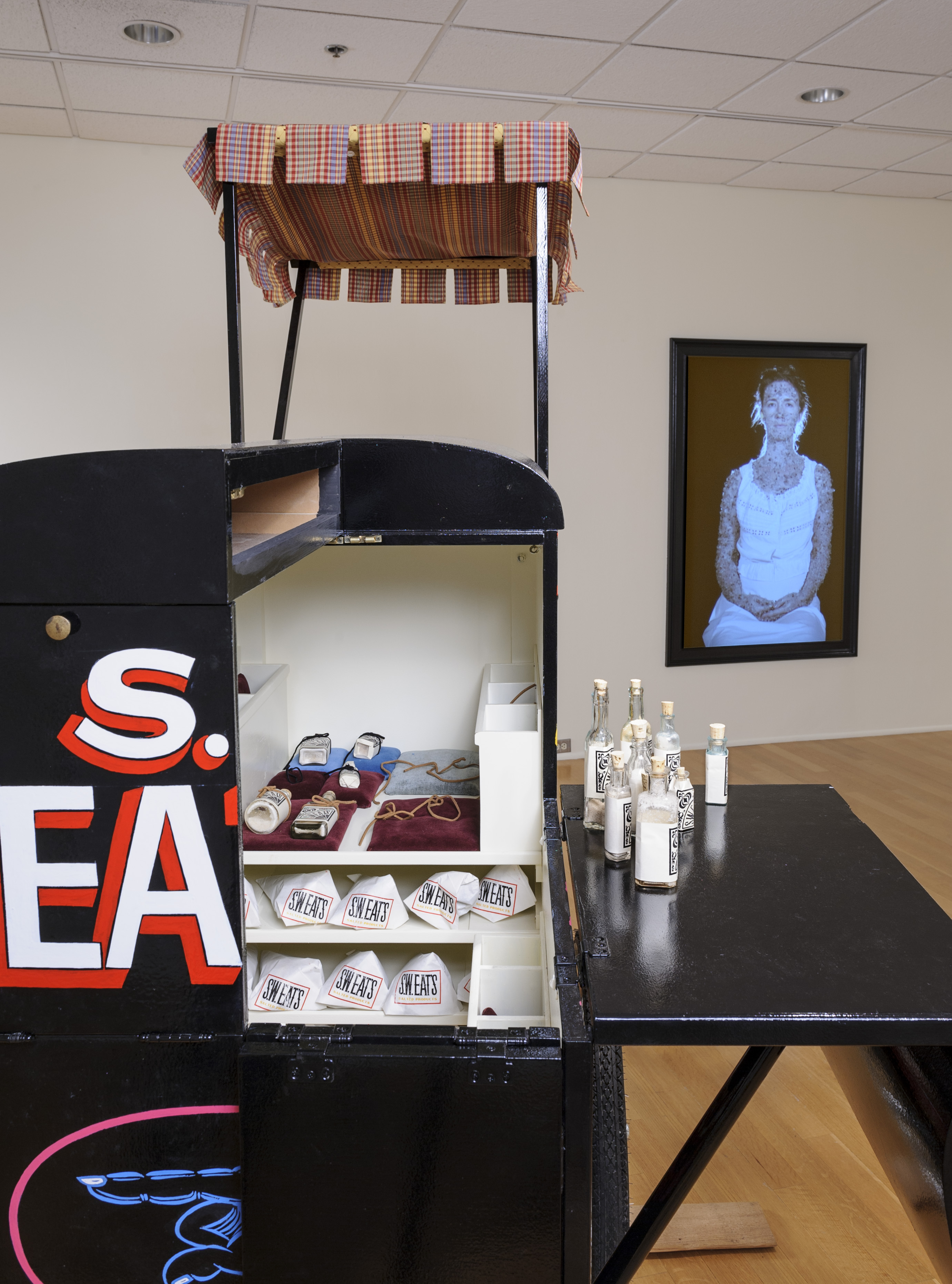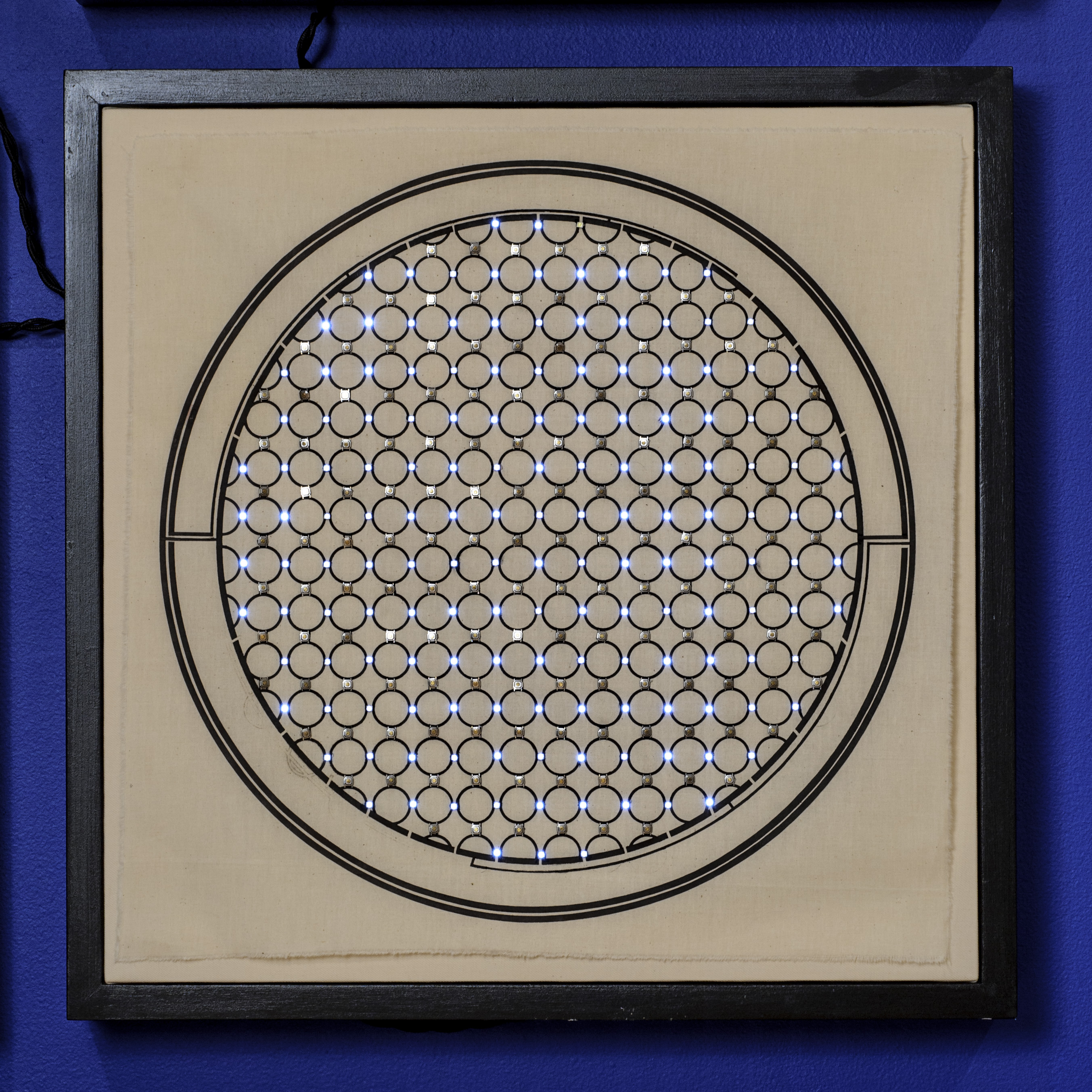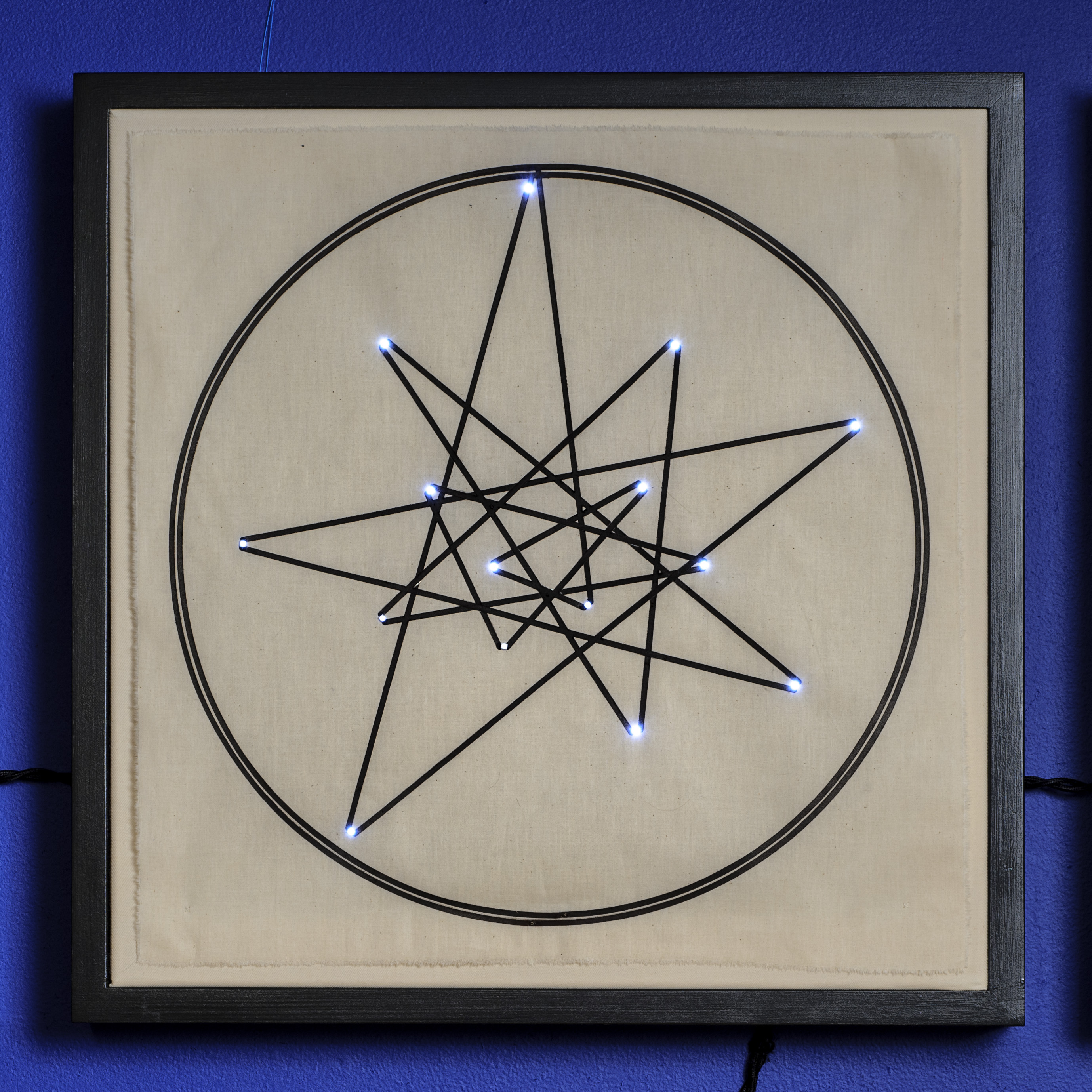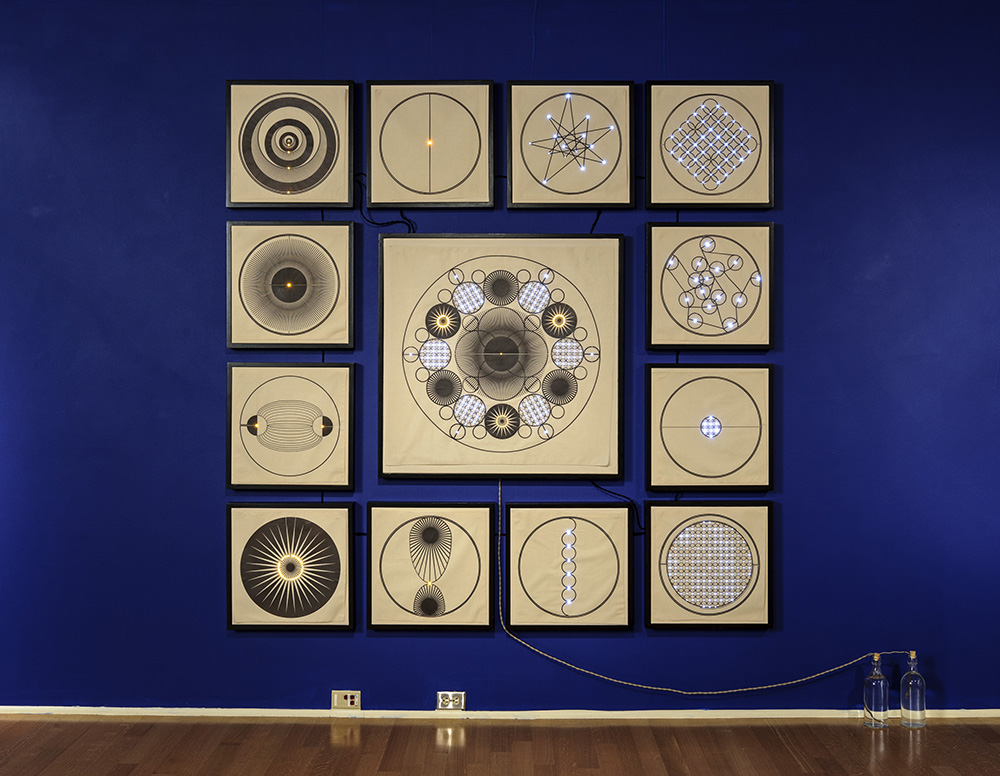About Olivia

Olivia Robinson is a multimedia artist whose work spans performance, installation, research, and community engagement. Robinson’s diverse body of work, which ranges in scale from hand-built textile circuits to architectural-scale inflatable structures, investigates issues of justice, identity, community, and transformation. She has received awards and honors from the National Endowment for the Arts, the New York State Council on the Arts, the Franklin Furnace Fund, the Harpo Foundation, the… more
Jump to a project:
Negotiations
Negotiations is a project that explores cross-cultural communication and interpretation. Over a period of two years Daniela Kostova and Olivia Robinson developed an interactive system that utilizes blue screen video techniques as a tool for manipulating human bodies moving through unknown environments. The system has been performed in three distinct public environments: Sardinia, Italy, New York City, USA and Sofia, Bulgaria. The first public performance of Negotiations took place in Sardinia, where a prototype of the system was deployed. Through the extended performances in New York and Sofia we further developed the system and used it to reveal more layers within the construct of the mythological ?other? by examining graffiti culture.
As both a conspicuous costume and virtual assimilation act, each performance has fostered the development of a site-specific story. Recurring themes that emerged from the performances include: estrangement and integration; cultural economics of ?authority?; placidity of legality, territory and ownership; and mediation of experience. The hand-held monitor which displays the ?negotiated? video in real-time becomes the focal point, allowing relationships to form during performances and highlighting the double-consciousness of cross-cultural communication. The Negotiations system uses readily available computer and surveillance technology to create the real-time video. Two characters embody the system, an Alien (in blue) and an Authority (in black). Each has a video camera which is linked to a computer embedded in the Authority's costume. Custom software composites the two video streams to create a negotiated final video. The resulting imagery is solely from the Authority's point of view wherein the Alien has been replaced with her or his own point of view. The Alien carries a small monitor where s/he and passers-by can view the final video as it is being created. The Authority rarely takes her camera off of the Alien, the surveilled subject.
As both a conspicuous costume and virtual assimilation act, each performance has fostered the development of a site-specific story. Recurring themes that emerged from the performances include: estrangement and integration; cultural economics of ?authority?; placidity of legality, territory and ownership; and mediation of experience. The hand-held monitor which displays the ?negotiated? video in real-time becomes the focal point, allowing relationships to form during performances and highlighting the double-consciousness of cross-cultural communication. The Negotiations system uses readily available computer and surveillance technology to create the real-time video. Two characters embody the system, an Alien (in blue) and an Authority (in black). Each has a video camera which is linked to a computer embedded in the Authority's costume. Custom software composites the two video streams to create a negotiated final video. The resulting imagery is solely from the Authority's point of view wherein the Alien has been replaced with her or his own point of view. The Alien carries a small monitor where s/he and passers-by can view the final video as it is being created. The Authority rarely takes her camera off of the Alien, the surveilled subject.
-
NegotiationsView of preparing the system for the street performance with the wearable video system. Materials: blue screen cloth, two video cameras, custom software, computer, fabric, cables, hand-held video screen. Negotiations is a project that explores cross-cultural communication and interpretation. Over a period of two years Daniela Kostova and Olivia Robinson developed an interactive system that utilizes blue screen video techniques as a tool for manipulating human bodies moving through unknown environments. The system has been performed in three distinct public environments: Sardinia, Italy, New York City, USA and Sofia, Bulgaria. The first public performance of Negotiations took place in Sardinia, where a prototype of the system was deployed. Through the extended performances in New York and Sofia we further developed the system and used it to reveal more layers within the construct of the mythological ?other? by examining graffiti culture. As both a conspicuous costume and virtual assimilation act, each performance has fostered the development of a site-specific story. Recurring themes that emerged from the performances include: estrangement and integration; cultural economics of ?authority?; placidity of legality, territory and ownership; and mediation of experience. The hand-held monitor which displays the ?negotiated? video in real-time becomes the focal point, allowing relationships to form during performances and highlighting the double-consciousness of cross-cultural communication. The Negotiations system uses readily available computer and surveillance technology to create the real-time video. Two characters embody the system, an Alien (in blue) and an Authority (in black). Each has a video camera which is linked to a computer embedded in the Authority's costume. Custom software composites the two video streams to create a negotiated final video. The resulting imagery is solely from the Authority's point of view wherein the Alien has been replaced with her or his own point of view. The Alien carries a small monitor where s/he and passers-by can view the final video as it is being created. The Authority rarely takes her camera off of the Alien, the surveilled subject.
-
NegotiationsView of preparing the system for the street performance with the wearable video system. Materials: blue screen cloth, two video cameras, custom software, computer, fabric, cables, hand-held video screen. Negotiations is a project that explores cross-cultural communication and interpretation. Over a period of two years Daniela Kostova and Olivia Robinson developed an interactive system that utilizes blue screen video techniques as a tool for manipulating human bodies moving through unknown environments. The system has been performed in three distinct public environments: Sardinia, Italy, New York City, USA and Sofia, Bulgaria. The first public performance of Negotiations took place in Sardinia, where a prototype of the system was deployed. Through the extended performances in New York and Sofia we further developed the system and used it to reveal more layers within the construct of the mythological ?other? by examining graffiti culture. As both a conspicuous costume and virtual assimilation act, each performance has fostered the development of a site-specific story. Recurring themes that emerged from the performances include: estrangement and integration; cultural economics of ?authority?; placidity of legality, territory and ownership; and mediation of experience. The hand-held monitor which displays the ?negotiated? video in real-time becomes the focal point, allowing relationships to form during performances and highlighting the double-consciousness of cross-cultural communication. The Negotiations system uses readily available computer and surveillance technology to create the real-time video. Two characters embody the system, an Alien (in blue) and an Authority (in black). Each has a video camera which is linked to a computer embedded in the Authority's costume. Custom software composites the two video streams to create a negotiated final video. The resulting imagery is solely from the Authority's point of view wherein the Alien has been replaced with her or his own point of view. The Alien carries a small monitor where s/he and passers-by can view the final video as it is being created. The Authority rarely takes her camera off of the Alien, the surveilled subject.
-
NegotiationsShort video example of the video created within the interactive live video system.
-
NegotiationsView street performance with the wearable video system. Materials: blue screen cloth, two video cameras, custom software, computer, fabric, cables, hand-held video screen. Negotiations is a project that explores cross-cultural communication and interpretation. Over a period of two years Daniela Kostova and Olivia Robinson developed an interactive system that utilizes blue screen video techniques as a tool for manipulating human bodies moving through unknown environments. The system has been performed in three distinct public environments: Sardinia, Italy, New York City, USA and Sofia, Bulgaria. The first public performance of Negotiations took place in Sardinia, where a prototype of the system was deployed. Through the extended performances in New York and Sofia we further developed the system and used it to reveal more layers within the construct of the mythological ?other? by examining graffiti culture. As both a conspicuous costume and virtual assimilation act, each performance has fostered the development of a site-specific story. Recurring themes that emerged from the performances include: estrangement and integration; cultural economics of ?authority?; placidity of legality, territory and ownership; and mediation of experience. The hand-held monitor which displays the ?negotiated? video in real-time becomes the focal point, allowing relationships to form during performances and highlighting the double-consciousness of cross-cultural communication. The Negotiations system uses readily available computer and surveillance technology to create the real-time video. Two characters embody the system, an Alien (in blue) and an Authority (in black). Each has a video camera which is linked to a computer embedded in the Authority's costume. Custom software composites the two video streams to create a negotiated final video. The resulting imagery is solely from the Authority's point of view wherein the Alien has been replaced with her or his own point of view. The Alien carries a small monitor where s/he and passers-by can view the final video as it is being created. The Authority rarely takes her camera off of the Alien, the surveilled subject.
-
NegotiationsView street performance with the wearable video system. Materials: blue screen cloth, two video cameras, custom software, computer, fabric, cables, hand-held video screen. Negotiations is a project that explores cross-cultural communication and interpretation. Over a period of two years Daniela Kostova and Olivia Robinson developed an interactive system that utilizes blue screen video techniques as a tool for manipulating human bodies moving through unknown environments. The system has been performed in three distinct public environments: Sardinia, Italy, New York City, USA and Sofia, Bulgaria. The first public performance of Negotiations took place in Sardinia, where a prototype of the system was deployed. Through the extended performances in New York and Sofia we further developed the system and used it to reveal more layers within the construct of the mythological ?other? by examining graffiti culture. As both a conspicuous costume and virtual assimilation act, each performance has fostered the development of a site-specific story. Recurring themes that emerged from the performances include: estrangement and integration; cultural economics of ?authority?; placidity of legality, territory and ownership; and mediation of experience. The hand-held monitor which displays the ?negotiated? video in real-time becomes the focal point, allowing relationships to form during performances and highlighting the double-consciousness of cross-cultural communication. The Negotiations system uses readily available computer and surveillance technology to create the real-time video. Two characters embody the system, an Alien (in blue) and an Authority (in black). Each has a video camera which is linked to a computer embedded in the Authority's costume. Custom software composites the two video streams to create a negotiated final video. The resulting imagery is solely from the Authority's point of view wherein the Alien has been replaced with her or his own point of view. The Alien carries a small monitor where s/he and passers-by can view the final video as it is being created. The Authority rarely takes her camera off of the Alien, the surveilled subject.
-
NegotiationsDetail view of monitor and wearable video system. Materials: blue screen cloth, two video cameras, custom software, computer, fabric, cables, hand-held video screen. Negotiations is a project that explores cross-cultural communication and interpretation. Over a period of two years Daniela Kostova and Olivia Robinson developed an interactive system that utilizes blue screen video techniques as a tool for manipulating human bodies moving through unknown environments. The system has been performed in three distinct public environments: Sardinia, Italy, New York City, USA and Sofia, Bulgaria. The first public performance of Negotiations took place in Sardinia, where a prototype of the system was deployed. Through the extended performances in New York and Sofia we further developed the system and used it to reveal more layers within the construct of the mythological ?other? by examining graffiti culture. As both a conspicuous costume and virtual assimilation act, each performance has fostered the development of a site-specific story. Recurring themes that emerged from the performances include: estrangement and integration; cultural economics of ?authority?; placidity of legality, territory and ownership; and mediation of experience. The hand-held monitor which displays the ?negotiated? video in real-time becomes the focal point, allowing relationships to form during performances and highlighting the double-consciousness of cross-cultural communication. The Negotiations system uses readily available computer and surveillance technology to create the real-time video. Two characters embody the system, an Alien (in blue) and an Authority (in black). Each has a video camera which is linked to a computer embedded in the Authority's costume. Custom software composites the two video streams to create a negotiated final video. The resulting imagery is solely from the Authority's point of view wherein the Alien has been replaced with her or his own point of view. The Alien carries a small monitor where s/he and passers-by can view the final video as it is being created. The Authority rarely takes her camera off of the Alien, the surveilled subject.
-
 NegotiationsView of the resulting video produced with the wearable video system. Materials: blue screen cloth, two video cameras, custom software, computer, fabric, cables, hand-held video screen. Negotiations is a project that explores cross-cultural communication and interpretation. Over a period of two years Daniela Kostova and Olivia Robinson developed an interactive system that utilizes blue screen video techniques as a tool for manipulating human bodies moving through unknown environments. The system has been performed in three distinct public environments: Sardinia, Italy, New York City, USA and Sofia, Bulgaria. The first public performance of Negotiations took place in Sardinia, where a prototype of the system was deployed. Through the extended performances in New York and Sofia we further developed the system and used it to reveal more layers within the construct of the mythological ?other? by examining graffiti culture. As both a conspicuous costume and virtual assimilation act, each performance has fostered the development of a site-specific story. Recurring themes that emerged from the performances include: estrangement and integration; cultural economics of ?authority?; placidity of legality, territory and ownership; and mediation of experience. The hand-held monitor which displays the ?negotiated? video in real-time becomes the focal point, allowing relationships to form during performances and highlighting the double-consciousness of cross-cultural communication. The Negotiations system uses readily available computer and surveillance technology to create the real-time video. Two characters embody the system, an Alien (in blue) and an Authority (in black). Each has a video camera which is linked to a computer embedded in the Authority's costume. Custom software composites the two video streams to create a negotiated final video. The resulting imagery is solely from the Authority's point of view wherein the Alien has been replaced with her or his own point of view. The Alien carries a small monitor where s/he and passers-by can view the final video as it is being created. The Authority rarely takes her camera off of the Alien, the surveilled subject.
NegotiationsView of the resulting video produced with the wearable video system. Materials: blue screen cloth, two video cameras, custom software, computer, fabric, cables, hand-held video screen. Negotiations is a project that explores cross-cultural communication and interpretation. Over a period of two years Daniela Kostova and Olivia Robinson developed an interactive system that utilizes blue screen video techniques as a tool for manipulating human bodies moving through unknown environments. The system has been performed in three distinct public environments: Sardinia, Italy, New York City, USA and Sofia, Bulgaria. The first public performance of Negotiations took place in Sardinia, where a prototype of the system was deployed. Through the extended performances in New York and Sofia we further developed the system and used it to reveal more layers within the construct of the mythological ?other? by examining graffiti culture. As both a conspicuous costume and virtual assimilation act, each performance has fostered the development of a site-specific story. Recurring themes that emerged from the performances include: estrangement and integration; cultural economics of ?authority?; placidity of legality, territory and ownership; and mediation of experience. The hand-held monitor which displays the ?negotiated? video in real-time becomes the focal point, allowing relationships to form during performances and highlighting the double-consciousness of cross-cultural communication. The Negotiations system uses readily available computer and surveillance technology to create the real-time video. Two characters embody the system, an Alien (in blue) and an Authority (in black). Each has a video camera which is linked to a computer embedded in the Authority's costume. Custom software composites the two video streams to create a negotiated final video. The resulting imagery is solely from the Authority's point of view wherein the Alien has been replaced with her or his own point of view. The Alien carries a small monitor where s/he and passers-by can view the final video as it is being created. The Authority rarely takes her camera off of the Alien, the surveilled subject. -
 NegotiationsView of the resulting video produced with the wearable video system. Materials: blue screen cloth, two video cameras, custom software, computer, fabric, cables, hand-held video screen. Negotiations is a project that explores cross-cultural communication and interpretation. Over a period of two years Daniela Kostova and Olivia Robinson developed an interactive system that utilizes blue screen video techniques as a tool for manipulating human bodies moving through unknown environments. The system has been performed in three distinct public environments: Sardinia, Italy, New York City, USA and Sofia, Bulgaria. The first public performance of Negotiations took place in Sardinia, where a prototype of the system was deployed. Through the extended performances in New York and Sofia we further developed the system and used it to reveal more layers within the construct of the mythological ?other? by examining graffiti culture. As both a conspicuous costume and virtual assimilation act, each performance has fostered the development of a site-specific story. Recurring themes that emerged from the performances include: estrangement and integration; cultural economics of ?authority?; placidity of legality, territory and ownership; and mediation of experience. The hand-held monitor which displays the ?negotiated? video in real-time becomes the focal point, allowing relationships to form during performances and highlighting the double-consciousness of cross-cultural communication. The Negotiations system uses readily available computer and surveillance technology to create the real-time video. Two characters embody the system, an Alien (in blue) and an Authority (in black). Each has a video camera which is linked to a computer embedded in the Authority's costume. Custom software composites the two video streams to create a negotiated final video. The resulting imagery is solely from the Authority's point of view wherein the Alien has been replaced with her or his own point of view. The Alien carries a small monitor where s/he and passers-by can view the final video as it is being created. The Authority rarely takes her camera off of the Alien, the surveilled subject.
NegotiationsView of the resulting video produced with the wearable video system. Materials: blue screen cloth, two video cameras, custom software, computer, fabric, cables, hand-held video screen. Negotiations is a project that explores cross-cultural communication and interpretation. Over a period of two years Daniela Kostova and Olivia Robinson developed an interactive system that utilizes blue screen video techniques as a tool for manipulating human bodies moving through unknown environments. The system has been performed in three distinct public environments: Sardinia, Italy, New York City, USA and Sofia, Bulgaria. The first public performance of Negotiations took place in Sardinia, where a prototype of the system was deployed. Through the extended performances in New York and Sofia we further developed the system and used it to reveal more layers within the construct of the mythological ?other? by examining graffiti culture. As both a conspicuous costume and virtual assimilation act, each performance has fostered the development of a site-specific story. Recurring themes that emerged from the performances include: estrangement and integration; cultural economics of ?authority?; placidity of legality, territory and ownership; and mediation of experience. The hand-held monitor which displays the ?negotiated? video in real-time becomes the focal point, allowing relationships to form during performances and highlighting the double-consciousness of cross-cultural communication. The Negotiations system uses readily available computer and surveillance technology to create the real-time video. Two characters embody the system, an Alien (in blue) and an Authority (in black). Each has a video camera which is linked to a computer embedded in the Authority's costume. Custom software composites the two video streams to create a negotiated final video. The resulting imagery is solely from the Authority's point of view wherein the Alien has been replaced with her or his own point of view. The Alien carries a small monitor where s/he and passers-by can view the final video as it is being created. The Authority rarely takes her camera off of the Alien, the surveilled subject. -
 NegotiationsView street performance with the wearable video system. Materials: blue screen cloth, two video cameras, custom software, computer, fabric, cables, hand-held video screen. Negotiations is a project that explores cross-cultural communication and interpretation. Over a period of two years Daniela Kostova and Olivia Robinson developed an interactive system that utilizes blue screen video techniques as a tool for manipulating human bodies moving through unknown environments. The system has been performed in three distinct public environments: Sardinia, Italy, New York City, USA and Sofia, Bulgaria. The first public performance of Negotiations took place in Sardinia, where a prototype of the system was deployed. Through the extended performances in New York and Sofia we further developed the system and used it to reveal more layers within the construct of the mythological ?other? by examining graffiti culture. As both a conspicuous costume and virtual assimilation act, each performance has fostered the development of a site-specific story. Recurring themes that emerged from the performances include: estrangement and integration; cultural economics of ?authority?; placidity of legality, territory and ownership; and mediation of experience. The hand-held monitor which displays the ?negotiated? video in real-time becomes the focal point, allowing relationships to form during performances and highlighting the double-consciousness of cross-cultural communication. The Negotiations system uses readily available computer and surveillance technology to create the real-time video. Two characters embody the system, an Alien (in blue) and an Authority (in black). Each has a video camera which is linked to a computer embedded in the Authority's costume. Custom software composites the two video streams to create a negotiated final video. The resulting imagery is solely from the Authority's point of view wherein the Alien has been replaced with her or his own point of view. The Alien carries a small monitor where s/he and passers-by can view the final video as it is being created. The Authority rarely takes her camera off of the Alien, the surveilled subject.
NegotiationsView street performance with the wearable video system. Materials: blue screen cloth, two video cameras, custom software, computer, fabric, cables, hand-held video screen. Negotiations is a project that explores cross-cultural communication and interpretation. Over a period of two years Daniela Kostova and Olivia Robinson developed an interactive system that utilizes blue screen video techniques as a tool for manipulating human bodies moving through unknown environments. The system has been performed in three distinct public environments: Sardinia, Italy, New York City, USA and Sofia, Bulgaria. The first public performance of Negotiations took place in Sardinia, where a prototype of the system was deployed. Through the extended performances in New York and Sofia we further developed the system and used it to reveal more layers within the construct of the mythological ?other? by examining graffiti culture. As both a conspicuous costume and virtual assimilation act, each performance has fostered the development of a site-specific story. Recurring themes that emerged from the performances include: estrangement and integration; cultural economics of ?authority?; placidity of legality, territory and ownership; and mediation of experience. The hand-held monitor which displays the ?negotiated? video in real-time becomes the focal point, allowing relationships to form during performances and highlighting the double-consciousness of cross-cultural communication. The Negotiations system uses readily available computer and surveillance technology to create the real-time video. Two characters embody the system, an Alien (in blue) and an Authority (in black). Each has a video camera which is linked to a computer embedded in the Authority's costume. Custom software composites the two video streams to create a negotiated final video. The resulting imagery is solely from the Authority's point of view wherein the Alien has been replaced with her or his own point of view. The Alien carries a small monitor where s/he and passers-by can view the final video as it is being created. The Authority rarely takes her camera off of the Alien, the surveilled subject.
The Thing That Happened
A short seven minute science fiction film telling the story of a mysterious group in search of their lost Father, and the disastrous metaphysical experiment that ensues. The Thing That Happened is a story of dreams, desperation, and the unknown lessons of nature.
Spectres of Liberty: The Ghost of the Liberty Street Church
The Liberty Street Church is not only significant as a vanished part of Troy's architectural history, but also for its value as a historic site in the fight to abolish slavery. From old photos of the site provided by the Rensselaer Historical Society, we created an inflatable 1:1 scale reproduction of the church and installed it at the former site of the church, which is now a parking lot. We animated this ghost church through video projections that call forth the history of the site, as well as through the social context of a cultural event that brought community members to the site to think more deeply about the space and its history.
Through our research we learned more about Henry Highland Garnet, the pastor of Liberty Street Church from 1843-1848. He was known around the world for his militant orations and publications calling on people to actively participate in the fight to end slavery. When we read Henry Highland Garnet's words from the 1840's: "Let your motto be resistance! resistance! resistance! No oppressed people have ever secured their liberty without resistance," we do not think they are dead words from a forgotten time - but a call, an urging, to participate in transforming our world now.
Through our research we learned more about Henry Highland Garnet, the pastor of Liberty Street Church from 1843-1848. He was known around the world for his militant orations and publications calling on people to actively participate in the fight to end slavery. When we read Henry Highland Garnet's words from the 1840's: "Let your motto be resistance! resistance! resistance! No oppressed people have ever secured their liberty without resistance," we do not think they are dead words from a forgotten time - but a call, an urging, to participate in transforming our world now.
-
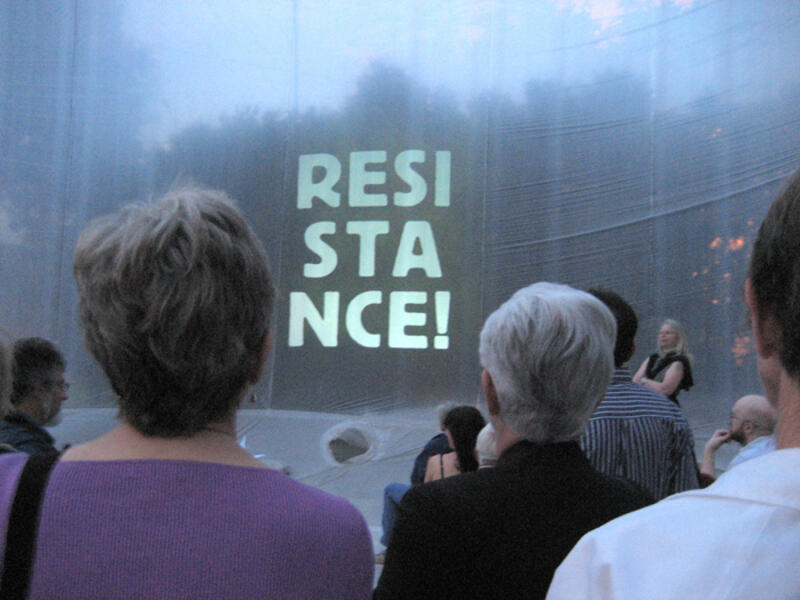 Ghost of the Liberty Street churchTemporary sculptural and video installation with community event. Materials: plastic, tape, wind, video projection. The Liberty Street Church is not only significant as a vanished part of Troy's architectural history, but also for its value as a historic site in the fight to abolish slavery. From old photos of the site provided by the Rensselaer Historical Society, we created an inflatable 1:1 scale reproduction of the church and installed it at the former site of the church, which is now a parking lot. We animated this ghost church through video projections that call forth the history of the site, as well as through the social context of a cultural event that brought community members to the site to think more deeply about the space and its history. Through our research we learned more about Henry Highland Garnet, the pastor of Liberty Street Church from 1843-1848. He was known around the world for his militant orations and publications calling on people to actively participate in the fight to end slavery. When we read Henry Highland Garnet's words from the 1840's: "Let your motto be resistance! resistance! resistance! No oppressed people have ever secured their liberty without resistance," we do not think they are dead words from a forgotten time - but a call, an urging, to participate in transforming our world now.
Ghost of the Liberty Street churchTemporary sculptural and video installation with community event. Materials: plastic, tape, wind, video projection. The Liberty Street Church is not only significant as a vanished part of Troy's architectural history, but also for its value as a historic site in the fight to abolish slavery. From old photos of the site provided by the Rensselaer Historical Society, we created an inflatable 1:1 scale reproduction of the church and installed it at the former site of the church, which is now a parking lot. We animated this ghost church through video projections that call forth the history of the site, as well as through the social context of a cultural event that brought community members to the site to think more deeply about the space and its history. Through our research we learned more about Henry Highland Garnet, the pastor of Liberty Street Church from 1843-1848. He was known around the world for his militant orations and publications calling on people to actively participate in the fight to end slavery. When we read Henry Highland Garnet's words from the 1840's: "Let your motto be resistance! resistance! resistance! No oppressed people have ever secured their liberty without resistance," we do not think they are dead words from a forgotten time - but a call, an urging, to participate in transforming our world now. -
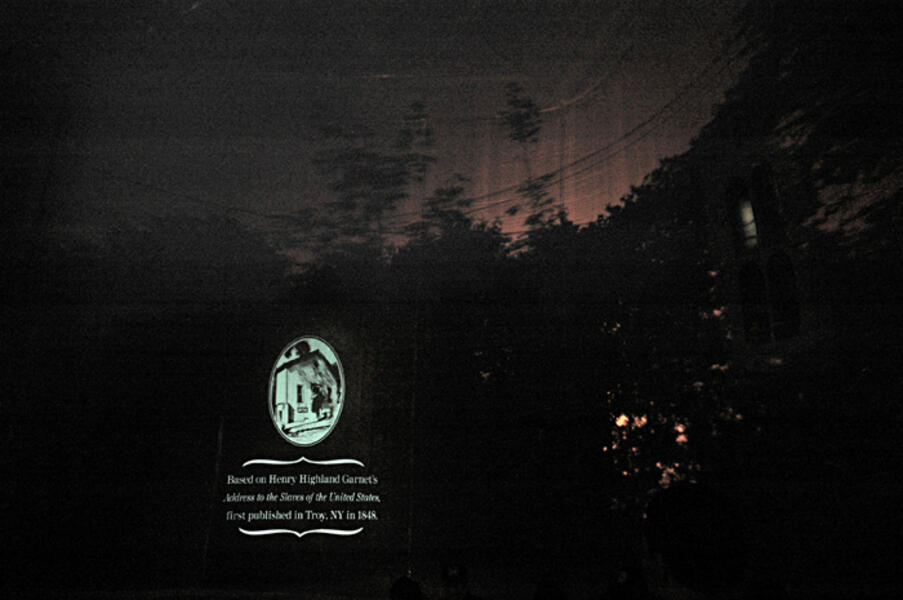 Ghost of the Liberty Street ChurchTemporary sculptural and video installation with community event. Materials: plastic, tape, wind, video projection. The Liberty Street Church is not only significant as a vanished part of Troy's architectural history, but also for its value as a historic site in the fight to abolish slavery. From old photos of the site provided by the Rensselaer Historical Society, we created an inflatable 1:1 scale reproduction of the church and installed it at the former site of the church, which is now a parking lot. We animated this ghost church through video projections that call forth the history of the site, as well as through the social context of a cultural event that brought community members to the site to think more deeply about the space and its history. Through our research we learned more about Henry Highland Garnet, the pastor of Liberty Street Church from 1843-1848. He was known around the world for his militant orations and publications calling on people to actively participate in the fight to end slavery. When we read Henry Highland Garnet's words from the 1840's: "Let your motto be resistance! resistance! resistance! No oppressed people have ever secured their liberty without resistance," we do not think they are dead words from a forgotten time - but a call, an urging, to participate in transforming our world now.
Ghost of the Liberty Street ChurchTemporary sculptural and video installation with community event. Materials: plastic, tape, wind, video projection. The Liberty Street Church is not only significant as a vanished part of Troy's architectural history, but also for its value as a historic site in the fight to abolish slavery. From old photos of the site provided by the Rensselaer Historical Society, we created an inflatable 1:1 scale reproduction of the church and installed it at the former site of the church, which is now a parking lot. We animated this ghost church through video projections that call forth the history of the site, as well as through the social context of a cultural event that brought community members to the site to think more deeply about the space and its history. Through our research we learned more about Henry Highland Garnet, the pastor of Liberty Street Church from 1843-1848. He was known around the world for his militant orations and publications calling on people to actively participate in the fight to end slavery. When we read Henry Highland Garnet's words from the 1840's: "Let your motto be resistance! resistance! resistance! No oppressed people have ever secured their liberty without resistance," we do not think they are dead words from a forgotten time - but a call, an urging, to participate in transforming our world now. -
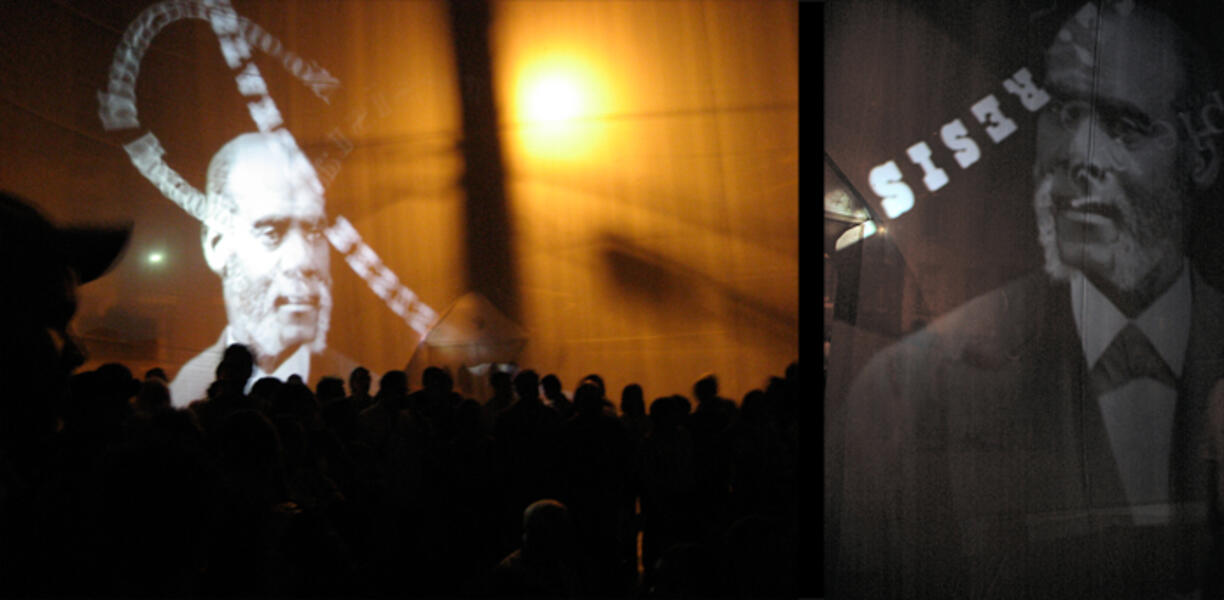 Ghost of the Liberty Street ChurchTemporary sculptural and video installation with community event. Materials: plastic, tape, wind, video projection. The Liberty Street Church is not only significant as a vanished part of Troy's architectural history, but also for its value as a historic site in the fight to abolish slavery. From old photos of the site provided by the Rensselaer Historical Society, we created an inflatable 1:1 scale reproduction of the church and installed it at the former site of the church, which is now a parking lot. We animated this ghost church through video projections that call forth the history of the site, as well as through the social context of a cultural event that brought community members to the site to think more deeply about the space and its history. Through our research we learned more about Henry Highland Garnet, the pastor of Liberty Street Church from 1843-1848. He was known around the world for his militant orations and publications calling on people to actively participate in the fight to end slavery. When we read Henry Highland Garnet's words from the 1840's: "Let your motto be resistance! resistance! resistance! No oppressed people have ever secured their liberty without resistance," we do not think they are dead words from a forgotten time - but a call, an urging, to participate in transforming our world now.
Ghost of the Liberty Street ChurchTemporary sculptural and video installation with community event. Materials: plastic, tape, wind, video projection. The Liberty Street Church is not only significant as a vanished part of Troy's architectural history, but also for its value as a historic site in the fight to abolish slavery. From old photos of the site provided by the Rensselaer Historical Society, we created an inflatable 1:1 scale reproduction of the church and installed it at the former site of the church, which is now a parking lot. We animated this ghost church through video projections that call forth the history of the site, as well as through the social context of a cultural event that brought community members to the site to think more deeply about the space and its history. Through our research we learned more about Henry Highland Garnet, the pastor of Liberty Street Church from 1843-1848. He was known around the world for his militant orations and publications calling on people to actively participate in the fight to end slavery. When we read Henry Highland Garnet's words from the 1840's: "Let your motto be resistance! resistance! resistance! No oppressed people have ever secured their liberty without resistance," we do not think they are dead words from a forgotten time - but a call, an urging, to participate in transforming our world now. -
 Ghost of the Liberty Street ChurchTemporary sculptural and video installation with community event. Materials: plastic, tape, wind, video projection. The Liberty Street Church is not only significant as a vanished part of Troy's architectural history, but also for its value as a historic site in the fight to abolish slavery. From old photos of the site provided by the Rensselaer Historical Society, we created an inflatable 1:1 scale reproduction of the church and installed it at the former site of the church, which is now a parking lot. We animated this ghost church through video projections that call forth the history of the site, as well as through the social context of a cultural event that brought community members to the site to think more deeply about the space and its history. Through our research we learned more about Henry Highland Garnet, the pastor of Liberty Street Church from 1843-1848. He was known around the world for his militant orations and publications calling on people to actively participate in the fight to end slavery. When we read Henry Highland Garnet's words from the 1840's: "Let your motto be resistance! resistance! resistance! No oppressed people have ever secured their liberty without resistance," we do not think they are dead words from a forgotten time - but a call, an urging, to participate in transforming our world now.
Ghost of the Liberty Street ChurchTemporary sculptural and video installation with community event. Materials: plastic, tape, wind, video projection. The Liberty Street Church is not only significant as a vanished part of Troy's architectural history, but also for its value as a historic site in the fight to abolish slavery. From old photos of the site provided by the Rensselaer Historical Society, we created an inflatable 1:1 scale reproduction of the church and installed it at the former site of the church, which is now a parking lot. We animated this ghost church through video projections that call forth the history of the site, as well as through the social context of a cultural event that brought community members to the site to think more deeply about the space and its history. Through our research we learned more about Henry Highland Garnet, the pastor of Liberty Street Church from 1843-1848. He was known around the world for his militant orations and publications calling on people to actively participate in the fight to end slavery. When we read Henry Highland Garnet's words from the 1840's: "Let your motto be resistance! resistance! resistance! No oppressed people have ever secured their liberty without resistance," we do not think they are dead words from a forgotten time - but a call, an urging, to participate in transforming our world now. -
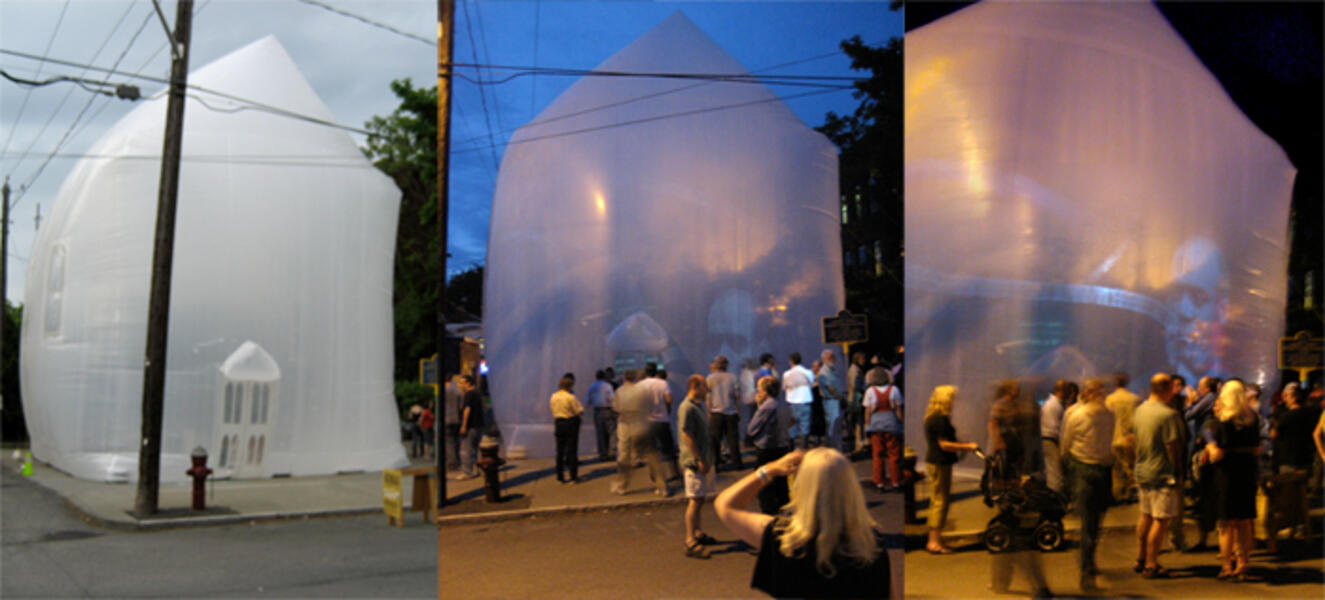 Ghost of the Liberty Street ChurchTemporary sculptural and video installation with community event. Materials: plastic, tape, wind, video projection. The Liberty Street Church is not only significant as a vanished part of Troy's architectural history, but also for its value as a historic site in the fight to abolish slavery. From old photos of the site provided by the Rensselaer Historical Society, we created an inflatable 1:1 scale reproduction of the church and installed it at the former site of the church, which is now a parking lot. We animated this ghost church through video projections that call forth the history of the site, as well as through the social context of a cultural event that brought community members to the site to think more deeply about the space and its history. Through our research we learned more about Henry Highland Garnet, the pastor of Liberty Street Church from 1843-1848. He was known around the world for his militant orations and publications calling on people to actively participate in the fight to end slavery. When we read Henry Highland Garnet's words from the 1840's: "Let your motto be resistance! resistance! resistance! No oppressed people have ever secured their liberty without resistance," we do not think they are dead words from a forgotten time - but a call, an urging, to participate in transforming our world now.
Ghost of the Liberty Street ChurchTemporary sculptural and video installation with community event. Materials: plastic, tape, wind, video projection. The Liberty Street Church is not only significant as a vanished part of Troy's architectural history, but also for its value as a historic site in the fight to abolish slavery. From old photos of the site provided by the Rensselaer Historical Society, we created an inflatable 1:1 scale reproduction of the church and installed it at the former site of the church, which is now a parking lot. We animated this ghost church through video projections that call forth the history of the site, as well as through the social context of a cultural event that brought community members to the site to think more deeply about the space and its history. Through our research we learned more about Henry Highland Garnet, the pastor of Liberty Street Church from 1843-1848. He was known around the world for his militant orations and publications calling on people to actively participate in the fight to end slavery. When we read Henry Highland Garnet's words from the 1840's: "Let your motto be resistance! resistance! resistance! No oppressed people have ever secured their liberty without resistance," we do not think they are dead words from a forgotten time - but a call, an urging, to participate in transforming our world now. -
Ghost of the Liberty Street ChurchFour minute video documentation of installation and community event.
-
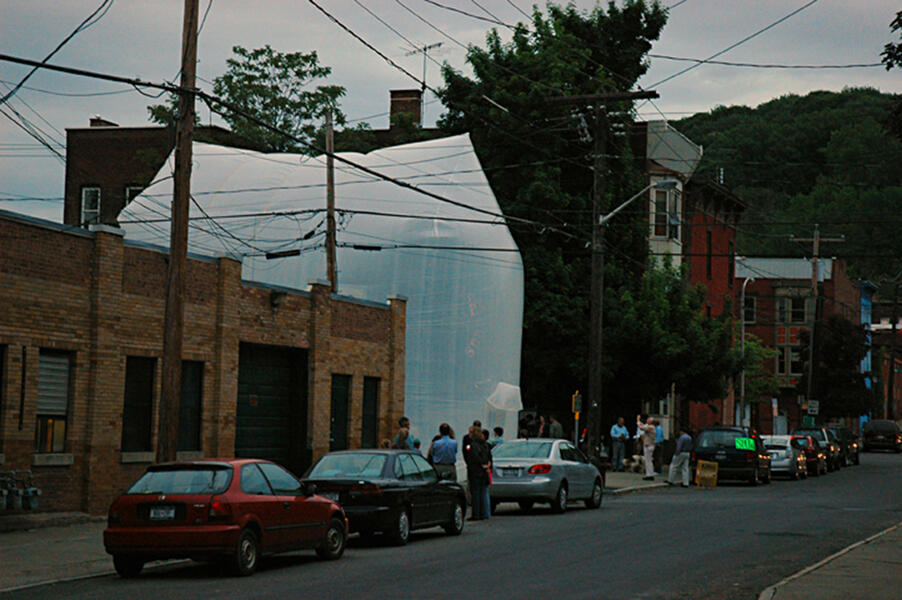 Ghost of the Liberty Street ChurchTemporary sculptural and video installation with community event. Materials: plastic, tape, wind, video projection. The Liberty Street Church is not only significant as a vanished part of Troy's architectural history, but also for its value as a historic site in the fight to abolish slavery. From old photos of the site provided by the Rensselaer Historical Society, we created an inflatable 1:1 scale reproduction of the church and installed it at the former site of the church, which is now a parking lot. We animated this ghost church through video projections that call forth the history of the site, as well as through the social context of a cultural event that brought community members to the site to think more deeply about the space and its history. Through our research we learned more about Henry Highland Garnet, the pastor of Liberty Street Church from 1843-1848. He was known around the world for his militant orations and publications calling on people to actively participate in the fight to end slavery. When we read Henry Highland Garnet's words from the 1840's: "Let your motto be resistance! resistance! resistance! No oppressed people have ever secured their liberty without resistance," we do not think they are dead words from a forgotten time - but a call, an urging, to participate in transforming our world now.
Ghost of the Liberty Street ChurchTemporary sculptural and video installation with community event. Materials: plastic, tape, wind, video projection. The Liberty Street Church is not only significant as a vanished part of Troy's architectural history, but also for its value as a historic site in the fight to abolish slavery. From old photos of the site provided by the Rensselaer Historical Society, we created an inflatable 1:1 scale reproduction of the church and installed it at the former site of the church, which is now a parking lot. We animated this ghost church through video projections that call forth the history of the site, as well as through the social context of a cultural event that brought community members to the site to think more deeply about the space and its history. Through our research we learned more about Henry Highland Garnet, the pastor of Liberty Street Church from 1843-1848. He was known around the world for his militant orations and publications calling on people to actively participate in the fight to end slavery. When we read Henry Highland Garnet's words from the 1840's: "Let your motto be resistance! resistance! resistance! No oppressed people have ever secured their liberty without resistance," we do not think they are dead words from a forgotten time - but a call, an urging, to participate in transforming our world now.
Waste to Work: Everyone's Source
Waste to Work explores the transformation of labor into electric power, using sweat as the link. Sweat is the perfect medium: it is an electrolyte that can be used to make galvanic batteries - "waste" that can be harvested from our labors - and remains an extremely personal commodity that holds our scent, essential salts, fats, pheromones. This project has multiple phases: building sweat batteries and sweat harvesting suits.
Wast to Work was a site specific installation at the Schenectady Museum of Science and Art. Inspired by the history and significance of General Electric to the local Schenectady community, this installation focused on visualizing global electrical power and physical labor. The installation was in a triptych format: a display of sweat batteries, a video of the process of collecting sweat, and an electrified map. We videotaped while collecting sweat from individuals living in New York state during our tee shirt exchange effort, and then we used the sweat and recycled containers to create 250 batteries. A system of wires (much like arteries and veins) connects these "organic" batteries to an illuminated LED world map based on the NASA satellite photo of the Earth at night. At the opening, the map was illuminated by the artists and audience as together they "charged" the batteries by adding the collected human sweat to the display of recycled bottles and creating electricity.
Wast to Work was a site specific installation at the Schenectady Museum of Science and Art. Inspired by the history and significance of General Electric to the local Schenectady community, this installation focused on visualizing global electrical power and physical labor. The installation was in a triptych format: a display of sweat batteries, a video of the process of collecting sweat, and an electrified map. We videotaped while collecting sweat from individuals living in New York state during our tee shirt exchange effort, and then we used the sweat and recycled containers to create 250 batteries. A system of wires (much like arteries and veins) connects these "organic" batteries to an illuminated LED world map based on the NASA satellite photo of the Earth at night. At the opening, the map was illuminated by the artists and audience as together they "charged" the batteries by adding the collected human sweat to the display of recycled bottles and creating electricity.
-
Waste to WorkFour minute video of our tee shirt exchange and sweat collection. This video is projected within the installation.
-
 Waste to WorkInstallation view of the wall of sweat batteries. Materials: LEDs, wire, paint, wood, jars, sweat, charcoal, aluminum, video. Waste to Work explores the transformation of labor into electric power, using sweat as the link. Sweat is the perfect medium: it is an electrolyte that can be used to make galvanic batteries - "waste" that can be harvested from our labors - and remains an extremely personal commodity that holds our scent, essential salts, fats, pheromones. This project has multiple phases: building sweat batteries and sweat harvesting suits. Wast to Work was a site specific installation at the Schenectady Museum of Science and Art. Inspired by the history and significance of General Electric to the local Schenectady community, this installation focused on visualizing global electrical power and physical labor. The installation was in a triptych format: a display of sweat batteries, a video of the process of collecting sweat, and an electrified map. We videotaped while collecting sweat from individuals living in New York state during our tee shirt exchange effort, and then we used the sweat and recycled containers to create 250 batteries. A system of wires (much like arteries and veins) connects these "organic" batteries to an illuminated LED world map based on the NASA satellite photo of the Earth at night. At the opening, the map was illuminated by the artists and audience as together they "charged" the batteries by adding the collected human sweat to the display of recycled bottles and creating electricity.
Waste to WorkInstallation view of the wall of sweat batteries. Materials: LEDs, wire, paint, wood, jars, sweat, charcoal, aluminum, video. Waste to Work explores the transformation of labor into electric power, using sweat as the link. Sweat is the perfect medium: it is an electrolyte that can be used to make galvanic batteries - "waste" that can be harvested from our labors - and remains an extremely personal commodity that holds our scent, essential salts, fats, pheromones. This project has multiple phases: building sweat batteries and sweat harvesting suits. Wast to Work was a site specific installation at the Schenectady Museum of Science and Art. Inspired by the history and significance of General Electric to the local Schenectady community, this installation focused on visualizing global electrical power and physical labor. The installation was in a triptych format: a display of sweat batteries, a video of the process of collecting sweat, and an electrified map. We videotaped while collecting sweat from individuals living in New York state during our tee shirt exchange effort, and then we used the sweat and recycled containers to create 250 batteries. A system of wires (much like arteries and veins) connects these "organic" batteries to an illuminated LED world map based on the NASA satellite photo of the Earth at night. At the opening, the map was illuminated by the artists and audience as together they "charged" the batteries by adding the collected human sweat to the display of recycled bottles and creating electricity. -
 Waste to WorkInstallation view of wire leading from wall of sweat batteries to LED map. Materials: LEDs, wire, paint, wood, jars, sweat, charcoal, aluminum, video. Waste to Work explores the transformation of labor into electric power, using sweat as the link. Sweat is the perfect medium: it is an electrolyte that can be used to make galvanic batteries - "waste" that can be harvested from our labors - and remains an extremely personal commodity that holds our scent, essential salts, fats, pheromones. This project has multiple phases: building sweat batteries and sweat harvesting suits. Wast to Work was a site specific installation at the Schenectady Museum of Science and Art. Inspired by the history and significance of General Electric to the local Schenectady community, this installation focused on visualizing global electrical power and physical labor. The installation was in a triptych format: a display of sweat batteries, a video of the process of collecting sweat, and an electrified map. We videotaped while collecting sweat from individuals living in New York state during our tee shirt exchange effort, and then we used the sweat and recycled containers to create 250 batteries. A system of wires (much like arteries and veins) connects these "organic" batteries to an illuminated LED world map based on the NASA satellite photo of the Earth at night. At the opening, the map was illuminated by the artists and audience as together they "charged" the batteries by adding the collected human sweat to the display of recycled bottles and creating electricity.
Waste to WorkInstallation view of wire leading from wall of sweat batteries to LED map. Materials: LEDs, wire, paint, wood, jars, sweat, charcoal, aluminum, video. Waste to Work explores the transformation of labor into electric power, using sweat as the link. Sweat is the perfect medium: it is an electrolyte that can be used to make galvanic batteries - "waste" that can be harvested from our labors - and remains an extremely personal commodity that holds our scent, essential salts, fats, pheromones. This project has multiple phases: building sweat batteries and sweat harvesting suits. Wast to Work was a site specific installation at the Schenectady Museum of Science and Art. Inspired by the history and significance of General Electric to the local Schenectady community, this installation focused on visualizing global electrical power and physical labor. The installation was in a triptych format: a display of sweat batteries, a video of the process of collecting sweat, and an electrified map. We videotaped while collecting sweat from individuals living in New York state during our tee shirt exchange effort, and then we used the sweat and recycled containers to create 250 batteries. A system of wires (much like arteries and veins) connects these "organic" batteries to an illuminated LED world map based on the NASA satellite photo of the Earth at night. At the opening, the map was illuminated by the artists and audience as together they "charged" the batteries by adding the collected human sweat to the display of recycled bottles and creating electricity. -
 Waste to WorkInstallation view of LEDs world map. Materials: LEDs, wire, paint, wood, jars, sweat, charcoal, aluminum, video. Waste to Work explores the transformation of labor into electric power, using sweat as the link. Sweat is the perfect medium: it is an electrolyte that can be used to make galvanic batteries - "waste" that can be harvested from our labors - and remains an extremely personal commodity that holds our scent, essential salts, fats, pheromones. This project has multiple phases: building sweat batteries and sweat harvesting suits. Wast to Work was a site specific installation at the Schenectady Museum of Science and Art. Inspired by the history and significance of General Electric to the local Schenectady community, this installation focused on visualizing global electrical power and physical labor. The installation was in a triptych format: a display of sweat batteries, a video of the process of collecting sweat, and an electrified map. We videotaped while collecting sweat from individuals living in New York state during our tee shirt exchange effort, and then we used the sweat and recycled containers to create 250 batteries. A system of wires (much like arteries and veins) connects these "organic" batteries to an illuminated LED world map based on the NASA satellite photo of the Earth at night. At the opening, the map was illuminated by the artists and audience as together they "charged" the batteries by adding the collected human sweat to the display of recycled bottles and creating electricity.
Waste to WorkInstallation view of LEDs world map. Materials: LEDs, wire, paint, wood, jars, sweat, charcoal, aluminum, video. Waste to Work explores the transformation of labor into electric power, using sweat as the link. Sweat is the perfect medium: it is an electrolyte that can be used to make galvanic batteries - "waste" that can be harvested from our labors - and remains an extremely personal commodity that holds our scent, essential salts, fats, pheromones. This project has multiple phases: building sweat batteries and sweat harvesting suits. Wast to Work was a site specific installation at the Schenectady Museum of Science and Art. Inspired by the history and significance of General Electric to the local Schenectady community, this installation focused on visualizing global electrical power and physical labor. The installation was in a triptych format: a display of sweat batteries, a video of the process of collecting sweat, and an electrified map. We videotaped while collecting sweat from individuals living in New York state during our tee shirt exchange effort, and then we used the sweat and recycled containers to create 250 batteries. A system of wires (much like arteries and veins) connects these "organic" batteries to an illuminated LED world map based on the NASA satellite photo of the Earth at night. At the opening, the map was illuminated by the artists and audience as together they "charged" the batteries by adding the collected human sweat to the display of recycled bottles and creating electricity. -
 Waste to WorkDetail view of LED map. Materials: LEDs, wire, paint, wood, jars, sweat, charcoal, aluminum, video. Waste to Work explores the transformation of labor into electric power, using sweat as the link. Sweat is the perfect medium: it is an electrolyte that can be used to make galvanic batteries - "waste" that can be harvested from our labors - and remains an extremely personal commodity that holds our scent, essential salts, fats, pheromones. This project has multiple phases: building sweat batteries and sweat harvesting suits. Wast to Work was a site specific installation at the Schenectady Museum of Science and Art. Inspired by the history and significance of General Electric to the local Schenectady community, this installation focused on visualizing global electrical power and physical labor. The installation was in a triptych format: a display of sweat batteries, a video of the process of collecting sweat, and an electrified map. We videotaped while collecting sweat from individuals living in New York state during our tee shirt exchange effort, and then we used the sweat and recycled containers to create 250 batteries. A system of wires (much like arteries and veins) connects these "organic" batteries to an illuminated LED world map based on the NASA satellite photo of the Earth at night. At the opening, the map was illuminated by the artists and audience as together they "charged" the batteries by adding the collected human sweat to the display of recycled bottles and creating electricity.
Waste to WorkDetail view of LED map. Materials: LEDs, wire, paint, wood, jars, sweat, charcoal, aluminum, video. Waste to Work explores the transformation of labor into electric power, using sweat as the link. Sweat is the perfect medium: it is an electrolyte that can be used to make galvanic batteries - "waste" that can be harvested from our labors - and remains an extremely personal commodity that holds our scent, essential salts, fats, pheromones. This project has multiple phases: building sweat batteries and sweat harvesting suits. Wast to Work was a site specific installation at the Schenectady Museum of Science and Art. Inspired by the history and significance of General Electric to the local Schenectady community, this installation focused on visualizing global electrical power and physical labor. The installation was in a triptych format: a display of sweat batteries, a video of the process of collecting sweat, and an electrified map. We videotaped while collecting sweat from individuals living in New York state during our tee shirt exchange effort, and then we used the sweat and recycled containers to create 250 batteries. A system of wires (much like arteries and veins) connects these "organic" batteries to an illuminated LED world map based on the NASA satellite photo of the Earth at night. At the opening, the map was illuminated by the artists and audience as together they "charged" the batteries by adding the collected human sweat to the display of recycled bottles and creating electricity. -
 Waste to WorkInstallation view of LEDs world map. Materials: LEDs, wire, paint, wood, jars, sweat, charcoal, aluminum, video. Waste to Work explores the transformation of labor into electric power, using sweat as the link. Sweat is the perfect medium: it is an electrolyte that can be used to make galvanic batteries - "waste" that can be harvested from our labors - and remains an extremely personal commodity that holds our scent, essential salts, fats, pheromones. This project has multiple phases: building sweat batteries and sweat harvesting suits. Wast to Work was a site specific installation at the Schenectady Museum of Science and Art. Inspired by the history and significance of General Electric to the local Schenectady community, this installation focused on visualizing global electrical power and physical labor. The installation was in a triptych format: a display of sweat batteries, a video of the process of collecting sweat, and an electrified map. We videotaped while collecting sweat from individuals living in New York state during our tee shirt exchange effort, and then we used the sweat and recycled containers to create 250 batteries. A system of wires (much like arteries and veins) connects these "organic" batteries to an illuminated LED world map based on the NASA satellite photo of the Earth at night. At the opening, the map was illuminated by the artists and audience as together they "charged" the batteries by adding the collected human sweat to the display of recycled bottles and creating electricity.
Waste to WorkInstallation view of LEDs world map. Materials: LEDs, wire, paint, wood, jars, sweat, charcoal, aluminum, video. Waste to Work explores the transformation of labor into electric power, using sweat as the link. Sweat is the perfect medium: it is an electrolyte that can be used to make galvanic batteries - "waste" that can be harvested from our labors - and remains an extremely personal commodity that holds our scent, essential salts, fats, pheromones. This project has multiple phases: building sweat batteries and sweat harvesting suits. Wast to Work was a site specific installation at the Schenectady Museum of Science and Art. Inspired by the history and significance of General Electric to the local Schenectady community, this installation focused on visualizing global electrical power and physical labor. The installation was in a triptych format: a display of sweat batteries, a video of the process of collecting sweat, and an electrified map. We videotaped while collecting sweat from individuals living in New York state during our tee shirt exchange effort, and then we used the sweat and recycled containers to create 250 batteries. A system of wires (much like arteries and veins) connects these "organic" batteries to an illuminated LED world map based on the NASA satellite photo of the Earth at night. At the opening, the map was illuminated by the artists and audience as together they "charged" the batteries by adding the collected human sweat to the display of recycled bottles and creating electricity. -
 Waste to WorkDetail view of the wall of sweat batteries. Materials: LEDs, wire, paint, wood, jars, sweat, charcoal, aluminum, video. Waste to Work explores the transformation of labor into electric power, using sweat as the link. Sweat is the perfect medium: it is an electrolyte that can be used to make galvanic batteries - "waste" that can be harvested from our labors - and remains an extremely personal commodity that holds our scent, essential salts, fats, pheromones. This project has multiple phases: building sweat batteries and sweat harvesting suits. Wast to Work was a site specific installation at the Schenectady Museum of Science and Art. Inspired by the history and significance of General Electric to the local Schenectady community, this installation focused on visualizing global electrical power and physical labor. The installation was in a triptych format: a display of sweat batteries, a video of the process of collecting sweat, and an electrified map. We videotaped while collecting sweat from individuals living in New York state during our tee shirt exchange effort, and then we used the sweat and recycled containers to create 250 batteries. A system of wires (much like arteries and veins) connects these "organic" batteries to an illuminated LED world map based on the NASA satellite photo of the Earth at night. At the opening, the map was illuminated by the artists and audience as together they "charged" the batteries by adding the collected human sweat to the display of recycled bottles and creating electricity.
Waste to WorkDetail view of the wall of sweat batteries. Materials: LEDs, wire, paint, wood, jars, sweat, charcoal, aluminum, video. Waste to Work explores the transformation of labor into electric power, using sweat as the link. Sweat is the perfect medium: it is an electrolyte that can be used to make galvanic batteries - "waste" that can be harvested from our labors - and remains an extremely personal commodity that holds our scent, essential salts, fats, pheromones. This project has multiple phases: building sweat batteries and sweat harvesting suits. Wast to Work was a site specific installation at the Schenectady Museum of Science and Art. Inspired by the history and significance of General Electric to the local Schenectady community, this installation focused on visualizing global electrical power and physical labor. The installation was in a triptych format: a display of sweat batteries, a video of the process of collecting sweat, and an electrified map. We videotaped while collecting sweat from individuals living in New York state during our tee shirt exchange effort, and then we used the sweat and recycled containers to create 250 batteries. A system of wires (much like arteries and veins) connects these "organic" batteries to an illuminated LED world map based on the NASA satellite photo of the Earth at night. At the opening, the map was illuminated by the artists and audience as together they "charged" the batteries by adding the collected human sweat to the display of recycled bottles and creating electricity. -
 Waste to WorkInstallation view of the sweat harvesting video. Materials: LEDs, wire, paint, wood, jars, sweat, charcoal, aluminum, video. Waste to Work explores the transformation of labor into electric power, using sweat as the link. Sweat is the perfect medium: it is an electrolyte that can be used to make galvanic batteries - "waste" that can be harvested from our labors - and remains an extremely personal commodity that holds our scent, essential salts, fats, pheromones. This project has multiple phases: building sweat batteries and sweat harvesting suits. Wast to Work was a site specific installation at the Schenectady Museum of Science and Art. Inspired by the history and significance of General Electric to the local Schenectady community, this installation focused on visualizing global electrical power and physical labor. The installation was in a triptych format: a display of sweat batteries, a video of the process of collecting sweat, and an electrified map. We videotaped while collecting sweat from individuals living in New York state during our tee shirt exchange effort, and then we used the sweat and recycled containers to create 250 batteries. A system of wires (much like arteries and veins) connects these "organic" batteries to an illuminated LED world map based on the NASA satellite photo of the Earth at night. At the opening, the map was illuminated by the artists and audience as together they "charged" the batteries by adding the collected human sweat to the display of recycled bottles and creating electricity.
Waste to WorkInstallation view of the sweat harvesting video. Materials: LEDs, wire, paint, wood, jars, sweat, charcoal, aluminum, video. Waste to Work explores the transformation of labor into electric power, using sweat as the link. Sweat is the perfect medium: it is an electrolyte that can be used to make galvanic batteries - "waste" that can be harvested from our labors - and remains an extremely personal commodity that holds our scent, essential salts, fats, pheromones. This project has multiple phases: building sweat batteries and sweat harvesting suits. Wast to Work was a site specific installation at the Schenectady Museum of Science and Art. Inspired by the history and significance of General Electric to the local Schenectady community, this installation focused on visualizing global electrical power and physical labor. The installation was in a triptych format: a display of sweat batteries, a video of the process of collecting sweat, and an electrified map. We videotaped while collecting sweat from individuals living in New York state during our tee shirt exchange effort, and then we used the sweat and recycled containers to create 250 batteries. A system of wires (much like arteries and veins) connects these "organic" batteries to an illuminated LED world map based on the NASA satellite photo of the Earth at night. At the opening, the map was illuminated by the artists and audience as together they "charged" the batteries by adding the collected human sweat to the display of recycled bottles and creating electricity. -
 Waste to WorkView of sweat batteries being activated. Materials: LEDs, wire, paint, wood, jars, sweat, charcoal, aluminum, video. Waste to Work explores the transformation of labor into electric power, using sweat as the link. Sweat is the perfect medium: it is an electrolyte that can be used to make galvanic batteries - "waste" that can be harvested from our labors - and remains an extremely personal commodity that holds our scent, essential salts, fats, pheromones. This project has multiple phases: building sweat batteries and sweat harvesting suits. Wast to Work was a site specific installation at the Schenectady Museum of Science and Art. Inspired by the history and significance of General Electric to the local Schenectady community, this installation focused on visualizing global electrical power and physical labor. The installation was in a triptych format: a display of sweat batteries, a video of the process of collecting sweat, and an electrified map. We videotaped while collecting sweat from individuals living in New York state during our tee shirt exchange effort, and then we used the sweat and recycled containers to create 250 batteries. A system of wires (much like arteries and veins) connects these "organic" batteries to an illuminated LED world map based on the NASA satellite photo of the Earth at night. At the opening, the map was illuminated by the artists and audience as together they "charged" the batteries by adding the collected human sweat to the display of recycled bottles and creating electricity.
Waste to WorkView of sweat batteries being activated. Materials: LEDs, wire, paint, wood, jars, sweat, charcoal, aluminum, video. Waste to Work explores the transformation of labor into electric power, using sweat as the link. Sweat is the perfect medium: it is an electrolyte that can be used to make galvanic batteries - "waste" that can be harvested from our labors - and remains an extremely personal commodity that holds our scent, essential salts, fats, pheromones. This project has multiple phases: building sweat batteries and sweat harvesting suits. Wast to Work was a site specific installation at the Schenectady Museum of Science and Art. Inspired by the history and significance of General Electric to the local Schenectady community, this installation focused on visualizing global electrical power and physical labor. The installation was in a triptych format: a display of sweat batteries, a video of the process of collecting sweat, and an electrified map. We videotaped while collecting sweat from individuals living in New York state during our tee shirt exchange effort, and then we used the sweat and recycled containers to create 250 batteries. A system of wires (much like arteries and veins) connects these "organic" batteries to an illuminated LED world map based on the NASA satellite photo of the Earth at night. At the opening, the map was illuminated by the artists and audience as together they "charged" the batteries by adding the collected human sweat to the display of recycled bottles and creating electricity. -
 Waste to WorkInstallation view of the wall of sweat batteries. Materials: LEDs, wire, paint, wood, jars, sweat, charcoal, aluminum, video. Waste to Work explores the transformation of labor into electric power, using sweat as the link. Sweat is the perfect medium: it is an electrolyte that can be used to make galvanic batteries - "waste" that can be harvested from our labors - and remains an extremely personal commodity that holds our scent, essential salts, fats, pheromones. This project has multiple phases: building sweat batteries and sweat harvesting suits. Wast to Work was a site specific installation at the Schenectady Museum of Science and Art. Inspired by the history and significance of General Electric to the local Schenectady community, this installation focused on visualizing global electrical power and physical labor. The installation was in a triptych format: a display of sweat batteries, a video of the process of collecting sweat, and an electrified map. We videotaped while collecting sweat from individuals living in New York state during our tee shirt exchange effort, and then we used the sweat and recycled containers to create 250 batteries. A system of wires (much like arteries and veins) connects these "organic" batteries to an illuminated LED world map based on the NASA satellite photo of the Earth at night. At the opening, the map was illuminated by the artists and audience as together they "charged" the batteries by adding the collected human sweat to the display of recycled bottles and creating electricity.
Waste to WorkInstallation view of the wall of sweat batteries. Materials: LEDs, wire, paint, wood, jars, sweat, charcoal, aluminum, video. Waste to Work explores the transformation of labor into electric power, using sweat as the link. Sweat is the perfect medium: it is an electrolyte that can be used to make galvanic batteries - "waste" that can be harvested from our labors - and remains an extremely personal commodity that holds our scent, essential salts, fats, pheromones. This project has multiple phases: building sweat batteries and sweat harvesting suits. Wast to Work was a site specific installation at the Schenectady Museum of Science and Art. Inspired by the history and significance of General Electric to the local Schenectady community, this installation focused on visualizing global electrical power and physical labor. The installation was in a triptych format: a display of sweat batteries, a video of the process of collecting sweat, and an electrified map. We videotaped while collecting sweat from individuals living in New York state during our tee shirt exchange effort, and then we used the sweat and recycled containers to create 250 batteries. A system of wires (much like arteries and veins) connects these "organic" batteries to an illuminated LED world map based on the NASA satellite photo of the Earth at night. At the opening, the map was illuminated by the artists and audience as together they "charged" the batteries by adding the collected human sweat to the display of recycled bottles and creating electricity.
Waste to Work: Anxiety Map
This is a depiction of the power of distilled anxiety, an emotional outcome of the economic downturn of the last few years. It also represents a dichotomy within the physiology of the body. We sweat when we are working and we sweat when we are anxious. What about sweating when we are anxious about not working?
The exhibit uses the by-product of anxiety - sweat - to portray anxiety levels in New York City.
The City is divided into its 261 zip codes, each represented by a glass jar. Using data collected from the New York State Labor Department, each jar is filled with sweat in relation to the unemployment rate in those zip codes. The jars are then turned into "sweat battery" cells that power LED lights on a map of the five burrows. The location of the LEDs correlates with the location of people who are unemployed, or "had their lights turned off". Sweat, the by-product of anxiety, becomes the power for this illustration.
2010 Unemployment Rate for Each of the Five Burroughs
Bronx 12.7%
Brooklyn 10.3%
Staten Island 8.7%
Queens 8.6%
Manhattan 7.9%
The exhibit uses the by-product of anxiety - sweat - to portray anxiety levels in New York City.
The City is divided into its 261 zip codes, each represented by a glass jar. Using data collected from the New York State Labor Department, each jar is filled with sweat in relation to the unemployment rate in those zip codes. The jars are then turned into "sweat battery" cells that power LED lights on a map of the five burrows. The location of the LEDs correlates with the location of people who are unemployed, or "had their lights turned off". Sweat, the by-product of anxiety, becomes the power for this illustration.
2010 Unemployment Rate for Each of the Five Burroughs
Bronx 12.7%
Brooklyn 10.3%
Staten Island 8.7%
Queens 8.6%
Manhattan 7.9%
-
 Waste to Work: Anxiety MapOutside view of installation, in upper window. Materials: LEDs, electricity, jars, sweat, wire, charcoal, aluminum, LED text sign, paint, wood. This is a depiction of the power of distilled anxiety, an emotional outcome of the economic downturn of the last few years. It also represents a dichotomy within the physiology of the body. We sweat when we are working and we sweat when we are anxious. What about sweating when we are anxious about not working? The exhibit uses the by-product of anxiety - sweat - to portray anxiety levels in New York City. The City is divided into its 261 zip codes, each represented by a glass jar. Using data collected from the New York State Labor Department, each jar is filled with sweat in relation to the unemployment rate in those zip codes. The jars are then turned into "sweat battery" cells that power LED lights on a map of the five burrows. The location of the LEDs correlates with the location of people who are unemployed, or "had their lights turned off". Sweat, the by-product of anxiety, becomes the power for this illustration. 2010 Unemployment Rate for Each of the Five Burroughs Bronx 12.7% Brooklyn 10.3% Staten Island 8.7% Queens 8.6% Manhattan 7.9%
Waste to Work: Anxiety MapOutside view of installation, in upper window. Materials: LEDs, electricity, jars, sweat, wire, charcoal, aluminum, LED text sign, paint, wood. This is a depiction of the power of distilled anxiety, an emotional outcome of the economic downturn of the last few years. It also represents a dichotomy within the physiology of the body. We sweat when we are working and we sweat when we are anxious. What about sweating when we are anxious about not working? The exhibit uses the by-product of anxiety - sweat - to portray anxiety levels in New York City. The City is divided into its 261 zip codes, each represented by a glass jar. Using data collected from the New York State Labor Department, each jar is filled with sweat in relation to the unemployment rate in those zip codes. The jars are then turned into "sweat battery" cells that power LED lights on a map of the five burrows. The location of the LEDs correlates with the location of people who are unemployed, or "had their lights turned off". Sweat, the by-product of anxiety, becomes the power for this illustration. 2010 Unemployment Rate for Each of the Five Burroughs Bronx 12.7% Brooklyn 10.3% Staten Island 8.7% Queens 8.6% Manhattan 7.9% -
 Waste to Work: Anxiety MapDetail view of installation. Materials: LEDs, electricity, jars, sweat, wire, charcoal, aluminum, LED text sign, paint, wood. This is a depiction of the power of distilled anxiety, an emotional outcome of the economic downturn of the last few years. It also represents a dichotomy within the physiology of the body. We sweat when we are working and we sweat when we are anxious. What about sweating when we are anxious about not working? The exhibit uses the by-product of anxiety - sweat - to portray anxiety levels in New York City. The City is divided into its 261 zip codes, each represented by a glass jar. Using data collected from the New York State Labor Department, each jar is filled with sweat in relation to the unemployment rate in those zip codes. The jars are then turned into "sweat battery" cells that power LED lights on a map of the five burrows. The location of the LEDs correlates with the location of people who are unemployed, or "had their lights turned off". Sweat, the by-product of anxiety, becomes the power for this illustration. 2010 Unemployment Rate for Each of the Five Burroughs Bronx 12.7% Brooklyn 10.3% Staten Island 8.7% Queens 8.6% Manhattan 7.9%
Waste to Work: Anxiety MapDetail view of installation. Materials: LEDs, electricity, jars, sweat, wire, charcoal, aluminum, LED text sign, paint, wood. This is a depiction of the power of distilled anxiety, an emotional outcome of the economic downturn of the last few years. It also represents a dichotomy within the physiology of the body. We sweat when we are working and we sweat when we are anxious. What about sweating when we are anxious about not working? The exhibit uses the by-product of anxiety - sweat - to portray anxiety levels in New York City. The City is divided into its 261 zip codes, each represented by a glass jar. Using data collected from the New York State Labor Department, each jar is filled with sweat in relation to the unemployment rate in those zip codes. The jars are then turned into "sweat battery" cells that power LED lights on a map of the five burrows. The location of the LEDs correlates with the location of people who are unemployed, or "had their lights turned off". Sweat, the by-product of anxiety, becomes the power for this illustration. 2010 Unemployment Rate for Each of the Five Burroughs Bronx 12.7% Brooklyn 10.3% Staten Island 8.7% Queens 8.6% Manhattan 7.9% -
 Waste to Work: Anxiety MapDetail view of installation. Materials: LEDs, electricity, jars, sweat, wire, charcoal, aluminum, LED text sign, paint, wood. This is a depiction of the power of distilled anxiety, an emotional outcome of the economic downturn of the last few years. It also represents a dichotomy within the physiology of the body. We sweat when we are working and we sweat when we are anxious. What about sweating when we are anxious about not working? The exhibit uses the by-product of anxiety - sweat - to portray anxiety levels in New York City. The City is divided into its 261 zip codes, each represented by a glass jar. Using data collected from the New York State Labor Department, each jar is filled with sweat in relation to the unemployment rate in those zip codes. The jars are then turned into "sweat battery" cells that power LED lights on a map of the five burrows. The location of the LEDs correlates with the location of people who are unemployed, or "had their lights turned off". Sweat, the by-product of anxiety, becomes the power for this illustration. 2010 Unemployment Rate for Each of the Five Burroughs Bronx 12.7% Brooklyn 10.3% Staten Island 8.7% Queens 8.6% Manhattan 7.9%
Waste to Work: Anxiety MapDetail view of installation. Materials: LEDs, electricity, jars, sweat, wire, charcoal, aluminum, LED text sign, paint, wood. This is a depiction of the power of distilled anxiety, an emotional outcome of the economic downturn of the last few years. It also represents a dichotomy within the physiology of the body. We sweat when we are working and we sweat when we are anxious. What about sweating when we are anxious about not working? The exhibit uses the by-product of anxiety - sweat - to portray anxiety levels in New York City. The City is divided into its 261 zip codes, each represented by a glass jar. Using data collected from the New York State Labor Department, each jar is filled with sweat in relation to the unemployment rate in those zip codes. The jars are then turned into "sweat battery" cells that power LED lights on a map of the five burrows. The location of the LEDs correlates with the location of people who are unemployed, or "had their lights turned off". Sweat, the by-product of anxiety, becomes the power for this illustration. 2010 Unemployment Rate for Each of the Five Burroughs Bronx 12.7% Brooklyn 10.3% Staten Island 8.7% Queens 8.6% Manhattan 7.9% -
 Waste to Work: Anxiety MapDetail view of installation. Materials: LEDs, electricity, jars, sweat, wire, charcoal, aluminum, LED text sign, paint, wood. This is a depiction of the power of distilled anxiety, an emotional outcome of the economic downturn of the last few years. It also represents a dichotomy within the physiology of the body. We sweat when we are working and we sweat when we are anxious. What about sweating when we are anxious about not working? The exhibit uses the by-product of anxiety - sweat - to portray anxiety levels in New York City. The City is divided into its 261 zip codes, each represented by a glass jar. Using data collected from the New York State Labor Department, each jar is filled with sweat in relation to the unemployment rate in those zip codes. The jars are then turned into "sweat battery" cells that power LED lights on a map of the five burrows. The location of the LEDs correlates with the location of people who are unemployed, or "had their lights turned off". Sweat, the by-product of anxiety, becomes the power for this illustration. 2010 Unemployment Rate for Each of the Five Burroughs Bronx 12.7% Brooklyn 10.3% Staten Island 8.7% Queens 8.6% Manhattan 7.9%
Waste to Work: Anxiety MapDetail view of installation. Materials: LEDs, electricity, jars, sweat, wire, charcoal, aluminum, LED text sign, paint, wood. This is a depiction of the power of distilled anxiety, an emotional outcome of the economic downturn of the last few years. It also represents a dichotomy within the physiology of the body. We sweat when we are working and we sweat when we are anxious. What about sweating when we are anxious about not working? The exhibit uses the by-product of anxiety - sweat - to portray anxiety levels in New York City. The City is divided into its 261 zip codes, each represented by a glass jar. Using data collected from the New York State Labor Department, each jar is filled with sweat in relation to the unemployment rate in those zip codes. The jars are then turned into "sweat battery" cells that power LED lights on a map of the five burrows. The location of the LEDs correlates with the location of people who are unemployed, or "had their lights turned off". Sweat, the by-product of anxiety, becomes the power for this illustration. 2010 Unemployment Rate for Each of the Five Burroughs Bronx 12.7% Brooklyn 10.3% Staten Island 8.7% Queens 8.6% Manhattan 7.9% -
 Waste to Work: Anxiety MapView of installation. Materials: LEDs, electricity, jars, sweat, wire, charcoal, aluminum, LED text sign, paint, wood. This is a depiction of the power of distilled anxiety, an emotional outcome of the economic downturn of the last few years. It also represents a dichotomy within the physiology of the body. We sweat when we are working and we sweat when we are anxious. What about sweating when we are anxious about not working? The exhibit uses the by-product of anxiety - sweat - to portray anxiety levels in New York City. The City is divided into its 261 zip codes, each represented by a glass jar. Using data collected from the New York State Labor Department, each jar is filled with sweat in relation to the unemployment rate in those zip codes. The jars are then turned into "sweat battery" cells that power LED lights on a map of the five burrows. The location of the LEDs correlates with the location of people who are unemployed, or "had their lights turned off". Sweat, the by-product of anxiety, becomes the power for this illustration. 2010 Unemployment Rate for Each of the Five Burroughs Bronx 12.7% Brooklyn 10.3% Staten Island 8.7% Queens 8.6% Manhattan 7.9%
Waste to Work: Anxiety MapView of installation. Materials: LEDs, electricity, jars, sweat, wire, charcoal, aluminum, LED text sign, paint, wood. This is a depiction of the power of distilled anxiety, an emotional outcome of the economic downturn of the last few years. It also represents a dichotomy within the physiology of the body. We sweat when we are working and we sweat when we are anxious. What about sweating when we are anxious about not working? The exhibit uses the by-product of anxiety - sweat - to portray anxiety levels in New York City. The City is divided into its 261 zip codes, each represented by a glass jar. Using data collected from the New York State Labor Department, each jar is filled with sweat in relation to the unemployment rate in those zip codes. The jars are then turned into "sweat battery" cells that power LED lights on a map of the five burrows. The location of the LEDs correlates with the location of people who are unemployed, or "had their lights turned off". Sweat, the by-product of anxiety, becomes the power for this illustration. 2010 Unemployment Rate for Each of the Five Burroughs Bronx 12.7% Brooklyn 10.3% Staten Island 8.7% Queens 8.6% Manhattan 7.9% -
 Waste to Work: Anxiety MapView of installation. Materials: LEDs, electricity, jars, sweat, wire, charcoal, aluminum, LED text sign, paint, wood. This is a depiction of the power of distilled anxiety, an emotional outcome of the economic downturn of the last few years. It also represents a dichotomy within the physiology of the body. We sweat when we are working and we sweat when we are anxious. What about sweating when we are anxious about not working? The exhibit uses the by-product of anxiety - sweat - to portray anxiety levels in New York City. The City is divided into its 261 zip codes, each represented by a glass jar. Using data collected from the New York State Labor Department, each jar is filled with sweat in relation to the unemployment rate in those zip codes. The jars are then turned into "sweat battery" cells that power LED lights on a map of the five burrows. The location of the LEDs correlates with the location of people who are unemployed, or "had their lights turned off". Sweat, the by-product of anxiety, becomes the power for this illustration. 2010 Unemployment Rate for Each of the Five Burroughs Bronx 12.7% Brooklyn 10.3% Staten Island 8.7% Queens 8.6% Manhattan 7.9%
Waste to Work: Anxiety MapView of installation. Materials: LEDs, electricity, jars, sweat, wire, charcoal, aluminum, LED text sign, paint, wood. This is a depiction of the power of distilled anxiety, an emotional outcome of the economic downturn of the last few years. It also represents a dichotomy within the physiology of the body. We sweat when we are working and we sweat when we are anxious. What about sweating when we are anxious about not working? The exhibit uses the by-product of anxiety - sweat - to portray anxiety levels in New York City. The City is divided into its 261 zip codes, each represented by a glass jar. Using data collected from the New York State Labor Department, each jar is filled with sweat in relation to the unemployment rate in those zip codes. The jars are then turned into "sweat battery" cells that power LED lights on a map of the five burrows. The location of the LEDs correlates with the location of people who are unemployed, or "had their lights turned off". Sweat, the by-product of anxiety, becomes the power for this illustration. 2010 Unemployment Rate for Each of the Five Burroughs Bronx 12.7% Brooklyn 10.3% Staten Island 8.7% Queens 8.6% Manhattan 7.9% -
 Waste to Work: Anxiety MapView of installation. Materials: LEDs, electricity, jars, sweat, wire, charcoal, aluminum, LED text sign, paint, wood. This is a depiction of the power of distilled anxiety, an emotional outcome of the economic downturn of the last few years. It also represents a dichotomy within the physiology of the body. We sweat when we are working and we sweat when we are anxious. What about sweating when we are anxious about not working? The exhibit uses the by-product of anxiety - sweat - to portray anxiety levels in New York City. The City is divided into its 261 zip codes, each represented by a glass jar. Using data collected from the New York State Labor Department, each jar is filled with sweat in relation to the unemployment rate in those zip codes. The jars are then turned into "sweat battery" cells that power LED lights on a map of the five burrows. The location of the LEDs correlates with the location of people who are unemployed, or "had their lights turned off". Sweat, the by-product of anxiety, becomes the power for this illustration. 2010 Unemployment Rate for Each of the Five Burroughs Bronx 12.7% Brooklyn 10.3% Staten Island 8.7% Queens 8.6% Manhattan 7.9%
Waste to Work: Anxiety MapView of installation. Materials: LEDs, electricity, jars, sweat, wire, charcoal, aluminum, LED text sign, paint, wood. This is a depiction of the power of distilled anxiety, an emotional outcome of the economic downturn of the last few years. It also represents a dichotomy within the physiology of the body. We sweat when we are working and we sweat when we are anxious. What about sweating when we are anxious about not working? The exhibit uses the by-product of anxiety - sweat - to portray anxiety levels in New York City. The City is divided into its 261 zip codes, each represented by a glass jar. Using data collected from the New York State Labor Department, each jar is filled with sweat in relation to the unemployment rate in those zip codes. The jars are then turned into "sweat battery" cells that power LED lights on a map of the five burrows. The location of the LEDs correlates with the location of people who are unemployed, or "had their lights turned off". Sweat, the by-product of anxiety, becomes the power for this illustration. 2010 Unemployment Rate for Each of the Five Burroughs Bronx 12.7% Brooklyn 10.3% Staten Island 8.7% Queens 8.6% Manhattan 7.9% -
 Waste to Work: Anxiety MapView of installation. Materials: LEDs, electricity, jars, sweat, wire, charcoal, aluminum, LED text sign, paint, wood. This is a depiction of the power of distilled anxiety, an emotional outcome of the economic downturn of the last few years. It also represents a dichotomy within the physiology of the body. We sweat when we are working and we sweat when we are anxious. What about sweating when we are anxious about not working? The exhibit uses the by-product of anxiety - sweat - to portray anxiety levels in New York City. The City is divided into its 261 zip codes, each represented by a glass jar. Using data collected from the New York State Labor Department, each jar is filled with sweat in relation to the unemployment rate in those zip codes. The jars are then turned into "sweat battery" cells that power LED lights on a map of the five burrows. The location of the LEDs correlates with the location of people who are unemployed, or "had their lights turned off". Sweat, the by-product of anxiety, becomes the power for this illustration. 2010 Unemployment Rate for Each of the Five Burroughs Bronx 12.7% Brooklyn 10.3% Staten Island 8.7% Queens 8.6% Manhattan 7.9%
Waste to Work: Anxiety MapView of installation. Materials: LEDs, electricity, jars, sweat, wire, charcoal, aluminum, LED text sign, paint, wood. This is a depiction of the power of distilled anxiety, an emotional outcome of the economic downturn of the last few years. It also represents a dichotomy within the physiology of the body. We sweat when we are working and we sweat when we are anxious. What about sweating when we are anxious about not working? The exhibit uses the by-product of anxiety - sweat - to portray anxiety levels in New York City. The City is divided into its 261 zip codes, each represented by a glass jar. Using data collected from the New York State Labor Department, each jar is filled with sweat in relation to the unemployment rate in those zip codes. The jars are then turned into "sweat battery" cells that power LED lights on a map of the five burrows. The location of the LEDs correlates with the location of people who are unemployed, or "had their lights turned off". Sweat, the by-product of anxiety, becomes the power for this illustration. 2010 Unemployment Rate for Each of the Five Burroughs Bronx 12.7% Brooklyn 10.3% Staten Island 8.7% Queens 8.6% Manhattan 7.9% -
 Waste to Work: Anxiety MapView of installation. Materials: LEDs, electricity, jars, sweat, wire, charcoal, aluminum, LED text sign, paint, wood. This is a depiction of the power of distilled anxiety, an emotional outcome of the economic downturn of the last few years. It also represents a dichotomy within the physiology of the body. We sweat when we are working and we sweat when we are anxious. What about sweating when we are anxious about not working? The exhibit uses the by-product of anxiety - sweat - to portray anxiety levels in New York City. The City is divided into its 261 zip codes, each represented by a glass jar. Using data collected from the New York State Labor Department, each jar is filled with sweat in relation to the unemployment rate in those zip codes. The jars are then turned into "sweat battery" cells that power LED lights on a map of the five burrows. The location of the LEDs correlates with the location of people who are unemployed, or "had their lights turned off". Sweat, the by-product of anxiety, becomes the power for this illustration. 2010 Unemployment Rate for Each of the Five Burroughs Bronx 12.7% Brooklyn 10.3% Staten Island 8.7% Queens 8.6% Manhattan 7.9%
Waste to Work: Anxiety MapView of installation. Materials: LEDs, electricity, jars, sweat, wire, charcoal, aluminum, LED text sign, paint, wood. This is a depiction of the power of distilled anxiety, an emotional outcome of the economic downturn of the last few years. It also represents a dichotomy within the physiology of the body. We sweat when we are working and we sweat when we are anxious. What about sweating when we are anxious about not working? The exhibit uses the by-product of anxiety - sweat - to portray anxiety levels in New York City. The City is divided into its 261 zip codes, each represented by a glass jar. Using data collected from the New York State Labor Department, each jar is filled with sweat in relation to the unemployment rate in those zip codes. The jars are then turned into "sweat battery" cells that power LED lights on a map of the five burrows. The location of the LEDs correlates with the location of people who are unemployed, or "had their lights turned off". Sweat, the by-product of anxiety, becomes the power for this illustration. 2010 Unemployment Rate for Each of the Five Burroughs Bronx 12.7% Brooklyn 10.3% Staten Island 8.7% Queens 8.6% Manhattan 7.9% -
 Waste to Work: Anxiety MapDetail view of installation. Materials: LEDs, electricity, jars, sweat, wire, charcoal, aluminum, LED text sign, paint, wood. This is a depiction of the power of distilled anxiety, an emotional outcome of the economic downturn of the last few years. It also represents a dichotomy within the physiology of the body. We sweat when we are working and we sweat when we are anxious. What about sweating when we are anxious about not working? The exhibit uses the by-product of anxiety - sweat - to portray anxiety levels in New York City. The City is divided into its 261 zip codes, each represented by a glass jar. Using data collected from the New York State Labor Department, each jar is filled with sweat in relation to the unemployment rate in those zip codes. The jars are then turned into "sweat battery" cells that power LED lights on a map of the five burrows. The location of the LEDs correlates with the location of people who are unemployed, or "had their lights turned off". Sweat, the by-product of anxiety, becomes the power for this illustration. 2010 Unemployment Rate for Each of the Five Burroughs Bronx 12.7% Brooklyn 10.3% Staten Island 8.7% Queens 8.6% Manhattan 7.9%
Waste to Work: Anxiety MapDetail view of installation. Materials: LEDs, electricity, jars, sweat, wire, charcoal, aluminum, LED text sign, paint, wood. This is a depiction of the power of distilled anxiety, an emotional outcome of the economic downturn of the last few years. It also represents a dichotomy within the physiology of the body. We sweat when we are working and we sweat when we are anxious. What about sweating when we are anxious about not working? The exhibit uses the by-product of anxiety - sweat - to portray anxiety levels in New York City. The City is divided into its 261 zip codes, each represented by a glass jar. Using data collected from the New York State Labor Department, each jar is filled with sweat in relation to the unemployment rate in those zip codes. The jars are then turned into "sweat battery" cells that power LED lights on a map of the five burrows. The location of the LEDs correlates with the location of people who are unemployed, or "had their lights turned off". Sweat, the by-product of anxiety, becomes the power for this illustration. 2010 Unemployment Rate for Each of the Five Burroughs Bronx 12.7% Brooklyn 10.3% Staten Island 8.7% Queens 8.6% Manhattan 7.9%
The Deathworks of May Elizabeth Kramner
May Elizabeth Kramner (1867-1977) was a recluse and an artist of the type now dubbed 'outsider.' Her life work consisted of a model of the town in which she lived. Each house was represented by a tent and on each tent was sewn the manner of death of a person (or persons) who lived in that house at some time during her life.
May Elizabeth's work was witnessed by no person outside of her immediate family during her lifetime. After her passing, the Deathworks were discovered by Charles and Dorothy Winright, the acclaimed anthropologists, but were destroyed in a fire shortly thereafter.
In 2011, The Poyais Group recreated the artworks based upon Dorothy Winwright's notes from her initial survey of May Elizabeth's tents and pavilions.
"We hope that the brilliant striving of this hermit may prove inspirational to others in this complicated time. We hope too that our tent-city will delight and astonish." - The Poyais Group, March 2011
May Elizabeth's work was witnessed by no person outside of her immediate family during her lifetime. After her passing, the Deathworks were discovered by Charles and Dorothy Winright, the acclaimed anthropologists, but were destroyed in a fire shortly thereafter.
In 2011, The Poyais Group recreated the artworks based upon Dorothy Winwright's notes from her initial survey of May Elizabeth's tents and pavilions.
"We hope that the brilliant striving of this hermit may prove inspirational to others in this complicated time. We hope too that our tent-city will delight and astonish." - The Poyais Group, March 2011
-
Deathworks of May Elizabeth KramnerSix minute video of the installation, providing an experience of the animating light and sound within the installation.
-
 Deathworks of May Elizabeth KramnerInstallation view. Materials: Fabric, lights, self-performing chord organs, wood, wire. May Elizabeth Kramner (1867-1977) was a recluse and an artist of the type now dubbed 'outsider.' Her life work consisted of a model of the town in which she lived. Each house was represented by a tent and on each tent was sewn the manner of death of a person (or persons) who lived in that house at some time during her life. May Elizabeth's work was witnessed by no person outside of her immediate family during her lifetime. After her passing, the Deathworks were discovered by Charles and Dorothy Winright, the acclaimed anthropologists, but were destroyed in a fire shortly thereafter. In 2011, The Poyais Group recreated the artworks based upon Dorothy Winwright's notes from her initial survey of May Elizabeth's tents and pavilions. "We hope that the brilliant striving of this hermit may prove inspirational to others in this complicated time. We hope too that our tent-city will delight and astonish." - The Poyais Group, March 2011
Deathworks of May Elizabeth KramnerInstallation view. Materials: Fabric, lights, self-performing chord organs, wood, wire. May Elizabeth Kramner (1867-1977) was a recluse and an artist of the type now dubbed 'outsider.' Her life work consisted of a model of the town in which she lived. Each house was represented by a tent and on each tent was sewn the manner of death of a person (or persons) who lived in that house at some time during her life. May Elizabeth's work was witnessed by no person outside of her immediate family during her lifetime. After her passing, the Deathworks were discovered by Charles and Dorothy Winright, the acclaimed anthropologists, but were destroyed in a fire shortly thereafter. In 2011, The Poyais Group recreated the artworks based upon Dorothy Winwright's notes from her initial survey of May Elizabeth's tents and pavilions. "We hope that the brilliant striving of this hermit may prove inspirational to others in this complicated time. We hope too that our tent-city will delight and astonish." - The Poyais Group, March 2011 -
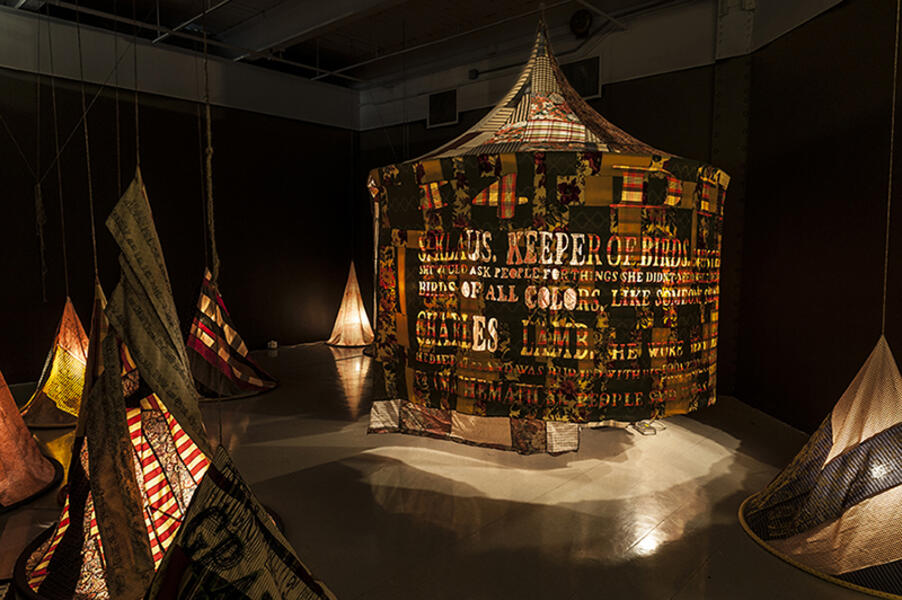 Deathworks of May Elizabeth KramnerInstallation view. Materials: Fabric, lights, self-performing chord organs, wood, wire. May Elizabeth Kramner (1867-1977) was a recluse and an artist of the type now dubbed 'outsider.' Her life work consisted of a model of the town in which she lived. Each house was represented by a tent and on each tent was sewn the manner of death of a person (or persons) who lived in that house at some time during her life. May Elizabeth's work was witnessed by no person outside of her immediate family during her lifetime. After her passing, the Deathworks were discovered by Charles and Dorothy Winright, the acclaimed anthropologists, but were destroyed in a fire shortly thereafter. In 2011, The Poyais Group recreated the artworks based upon Dorothy Winwright's notes from her initial survey of May Elizabeth's tents and pavilions. "We hope that the brilliant striving of this hermit may prove inspirational to others in this complicated time. We hope too that our tent-city will delight and astonish." - The Poyais Group, March 2011
Deathworks of May Elizabeth KramnerInstallation view. Materials: Fabric, lights, self-performing chord organs, wood, wire. May Elizabeth Kramner (1867-1977) was a recluse and an artist of the type now dubbed 'outsider.' Her life work consisted of a model of the town in which she lived. Each house was represented by a tent and on each tent was sewn the manner of death of a person (or persons) who lived in that house at some time during her life. May Elizabeth's work was witnessed by no person outside of her immediate family during her lifetime. After her passing, the Deathworks were discovered by Charles and Dorothy Winright, the acclaimed anthropologists, but were destroyed in a fire shortly thereafter. In 2011, The Poyais Group recreated the artworks based upon Dorothy Winwright's notes from her initial survey of May Elizabeth's tents and pavilions. "We hope that the brilliant striving of this hermit may prove inspirational to others in this complicated time. We hope too that our tent-city will delight and astonish." - The Poyais Group, March 2011
Context Posters
The one hundred and ninety-two Context Posters were derived from using a linguistic research database that allowed me to selectively search for words within popular texts published between the years 1890 and 1910. Within the database, I would look up a specific word, such as “Work”, and then ask the database to list for me the most used words written on either side of the word “Work” within those popular texts. From this list, I derived the three word concatenated poems that I hand-painted on each poster. Twelve words were searched: Power, Share, Work, Progress, Listen, Science, Labor, Sweat, Salt, Exchange, Health, and Waste.
The Context Posters were part of the exhibition titled, Olivia Robinson: 1899-1902. This exhibition examines a period of time now known as the “Technological Revolution.” Also known as the “Second Industrial Revolution,” this time period brought forth the internal combustion engine, new materials and substances (including alloys and chemicals), new communication technologies such as the telegraph and radio, and major advances in the use of electricity. The socioeconomic effects of these innovations would result in a radical shifting of social power structures that had been in place for centuries.
The work presented here spans a variety of media – painting, sculpture, photography, video, and electronic textiles. In the windows of the Stamp Gallery a series of 192 paintings deconstruct the language of the 19th century, grouping together words according to their most common coexistence in printed materials. A fully functional sales cart for peddling human sweat sits opposite a video of a woman demonstrating an unusual capacity for producing salt. A pew invites viewers to look upon a dramatic polyptych of thirteen electronic textile pieces. In all of these works, the time period of the Technological Revolution is used as a framework to explore issues of power, both scientific and social, and to reflect on how those issues continue to exist and evolve today.
The Context Posters were part of the exhibition titled, Olivia Robinson: 1899-1902. This exhibition examines a period of time now known as the “Technological Revolution.” Also known as the “Second Industrial Revolution,” this time period brought forth the internal combustion engine, new materials and substances (including alloys and chemicals), new communication technologies such as the telegraph and radio, and major advances in the use of electricity. The socioeconomic effects of these innovations would result in a radical shifting of social power structures that had been in place for centuries.
The work presented here spans a variety of media – painting, sculpture, photography, video, and electronic textiles. In the windows of the Stamp Gallery a series of 192 paintings deconstruct the language of the 19th century, grouping together words according to their most common coexistence in printed materials. A fully functional sales cart for peddling human sweat sits opposite a video of a woman demonstrating an unusual capacity for producing salt. A pew invites viewers to look upon a dramatic polyptych of thirteen electronic textile pieces. In all of these works, the time period of the Technological Revolution is used as a framework to explore issues of power, both scientific and social, and to reflect on how those issues continue to exist and evolve today.
-
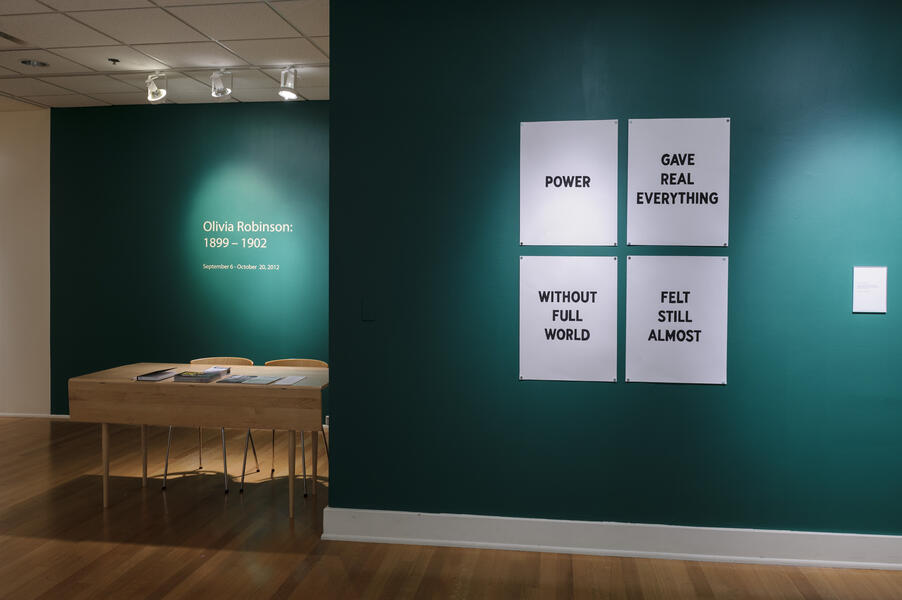 Context PostersInstallation of 192 word paintings. Materials: paper, paint, pins, wall. The one hundred and ninety-two Context Posters were derived from using a linguistic research database that allowed me to selectively search for words within popular texts published between the years 1890 and 1910. Within the database, I would look up a specific word, such as “Work”, and then ask the database to list for me the most used words written on either side of the word “Work” within those popular texts. From this list, I derived the three word concatenated poems that I hand-painted on each poster. Twelve words were searched: Power, Share, Work, Progress, Listen, Science, Labor, Sweat, Salt, Exchange, Health, and Waste. The Context Posters were part of the exhibition titled, Olivia Robinson: 1899-1902. This is a view of the entrance of the exhibition.
Context PostersInstallation of 192 word paintings. Materials: paper, paint, pins, wall. The one hundred and ninety-two Context Posters were derived from using a linguistic research database that allowed me to selectively search for words within popular texts published between the years 1890 and 1910. Within the database, I would look up a specific word, such as “Work”, and then ask the database to list for me the most used words written on either side of the word “Work” within those popular texts. From this list, I derived the three word concatenated poems that I hand-painted on each poster. Twelve words were searched: Power, Share, Work, Progress, Listen, Science, Labor, Sweat, Salt, Exchange, Health, and Waste. The Context Posters were part of the exhibition titled, Olivia Robinson: 1899-1902. This is a view of the entrance of the exhibition. -
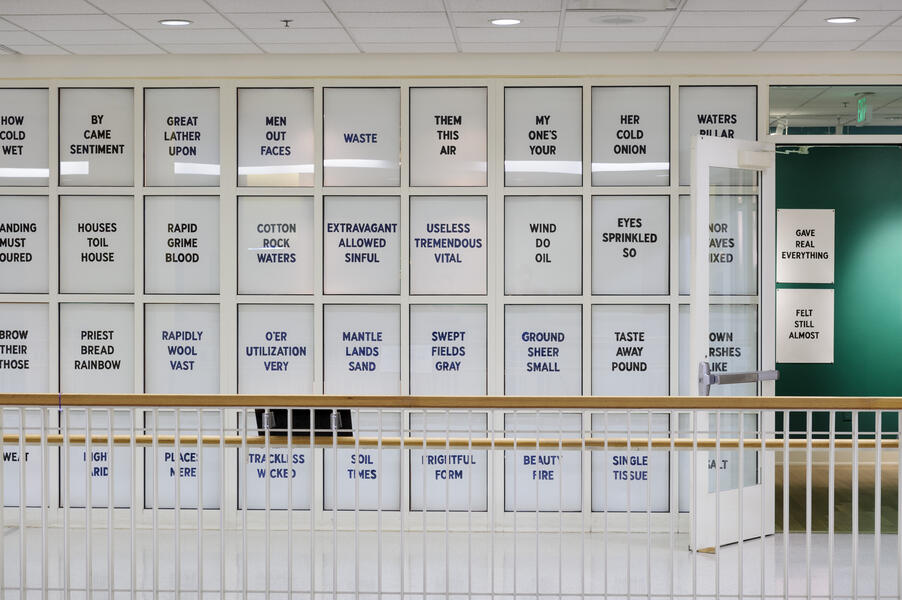 Context PostersInstallation of 192 word paintings. Materials: paper, paint, pins, wall. The one hundred and ninety-two Context Posters were derived from using a linguistic research database that allowed me to selectively search for words within popular texts published between the years 1890 and 1910. Within the database, I would look up a specific word, such as “Work”, and then ask the database to list for me the most used words written on either side of the word “Work” within those popular texts. From this list, I derived the three word concatenated poems that I hand-painted on each poster. Twelve words were searched: Power, Share, Work, Progress, Listen, Science, Labor, Sweat, Salt, Exchange, Health, and Waste. The Context Posters were part of the exhibition titled, Olivia Robinson: 1899-1902.
Context PostersInstallation of 192 word paintings. Materials: paper, paint, pins, wall. The one hundred and ninety-two Context Posters were derived from using a linguistic research database that allowed me to selectively search for words within popular texts published between the years 1890 and 1910. Within the database, I would look up a specific word, such as “Work”, and then ask the database to list for me the most used words written on either side of the word “Work” within those popular texts. From this list, I derived the three word concatenated poems that I hand-painted on each poster. Twelve words were searched: Power, Share, Work, Progress, Listen, Science, Labor, Sweat, Salt, Exchange, Health, and Waste. The Context Posters were part of the exhibition titled, Olivia Robinson: 1899-1902. -
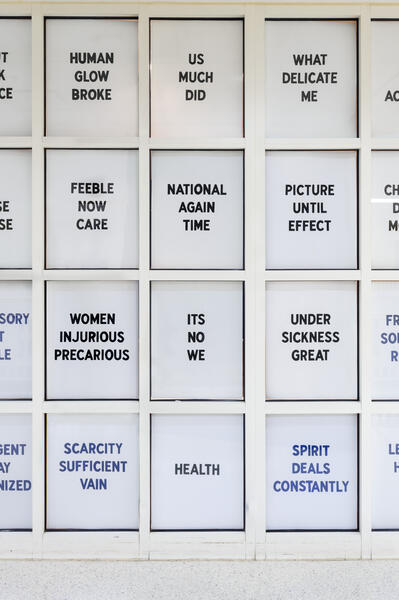 Context PostersThis photo focuses upon the cluster of word paintings related to HEALTH. Installation of 192 word paintings. Materials: paper, paint, pins, wall. The one hundred and ninety-two Context Posters were derived from using a linguistic research database that allowed me to selectively search for words within popular texts published between the years 1890 and 1910. Within the database, I would look up a specific word, such as “Work”, and then ask the database to list for me the most used words written on either side of the word “Work” within those popular texts. From this list, I derived the three word concatenated poems that I hand-painted on each poster. Twelve words were searched: Power, Share, Work, Progress, Listen, Science, Labor, Sweat, Salt, Exchange, Health, and Waste. The Context Posters were part of the exhibition titled, Olivia Robinson: 1899-1902.
Context PostersThis photo focuses upon the cluster of word paintings related to HEALTH. Installation of 192 word paintings. Materials: paper, paint, pins, wall. The one hundred and ninety-two Context Posters were derived from using a linguistic research database that allowed me to selectively search for words within popular texts published between the years 1890 and 1910. Within the database, I would look up a specific word, such as “Work”, and then ask the database to list for me the most used words written on either side of the word “Work” within those popular texts. From this list, I derived the three word concatenated poems that I hand-painted on each poster. Twelve words were searched: Power, Share, Work, Progress, Listen, Science, Labor, Sweat, Salt, Exchange, Health, and Waste. The Context Posters were part of the exhibition titled, Olivia Robinson: 1899-1902. -
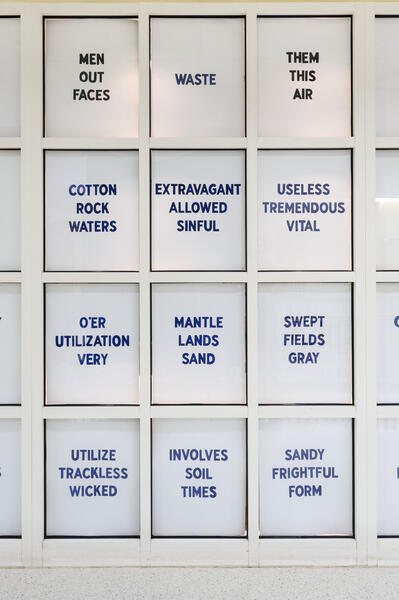 Context PostersThis photos focuses upon the cluster of word paintings related to the word WASTE. Installation of 192 word paintings. Materials: paper, paint, pins, wall. The one hundred and ninety-two Context Posters were derived from using a linguistic research database that allowed me to selectively search for words within popular texts published between the years 1890 and 1910. Within the database, I would look up a specific word, such as “Work”, and then ask the database to list for me the most used words written on either side of the word “Work” within those popular texts. From this list, I derived the three word concatenated poems that I hand-painted on each poster. Twelve words were searched: Power, Share, Work, Progress, Listen, Science, Labor, Sweat, Salt, Exchange, Health, and Waste. The Context Posters were part of the exhibition titled, Olivia Robinson: 1899-1902.
Context PostersThis photos focuses upon the cluster of word paintings related to the word WASTE. Installation of 192 word paintings. Materials: paper, paint, pins, wall. The one hundred and ninety-two Context Posters were derived from using a linguistic research database that allowed me to selectively search for words within popular texts published between the years 1890 and 1910. Within the database, I would look up a specific word, such as “Work”, and then ask the database to list for me the most used words written on either side of the word “Work” within those popular texts. From this list, I derived the three word concatenated poems that I hand-painted on each poster. Twelve words were searched: Power, Share, Work, Progress, Listen, Science, Labor, Sweat, Salt, Exchange, Health, and Waste. The Context Posters were part of the exhibition titled, Olivia Robinson: 1899-1902. -
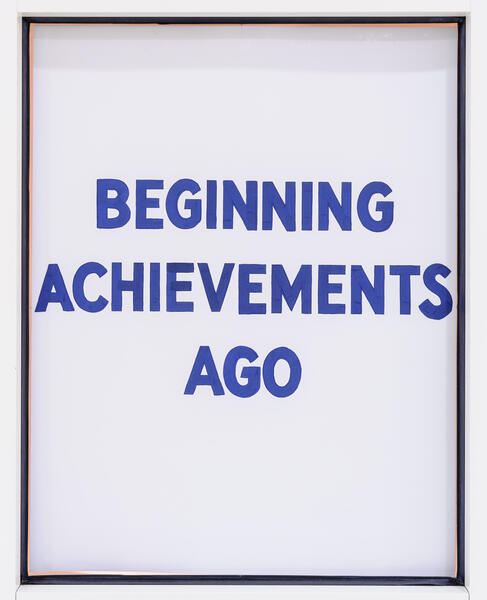 Context PostersInstallation of 192 word paintings. Materials: paper, paint, pins, wall. The one hundred and ninety-two Context Posters were derived from using a linguistic research database that allowed me to selectively search for words within popular texts published between the years 1890 and 1910. Within the database, I would look up a specific word, such as “Work”, and then ask the database to list for me the most used words written on either side of the word “Work” within those popular texts. From this list, I derived the three word concatenated poems that I hand-painted on each poster. Twelve words were searched: Power, Share, Work, Progress, Listen, Science, Labor, Sweat, Salt, Exchange, Health, and Waste. The Context Posters were part of the exhibition titled, Olivia Robinson: 1899-1902.
Context PostersInstallation of 192 word paintings. Materials: paper, paint, pins, wall. The one hundred and ninety-two Context Posters were derived from using a linguistic research database that allowed me to selectively search for words within popular texts published between the years 1890 and 1910. Within the database, I would look up a specific word, such as “Work”, and then ask the database to list for me the most used words written on either side of the word “Work” within those popular texts. From this list, I derived the three word concatenated poems that I hand-painted on each poster. Twelve words were searched: Power, Share, Work, Progress, Listen, Science, Labor, Sweat, Salt, Exchange, Health, and Waste. The Context Posters were part of the exhibition titled, Olivia Robinson: 1899-1902. -
 Context PostersInstallation of 192 word paintings. Materials: paper, paint, pins, wall. The one hundred and ninety-two Context Posters were derived from using a linguistic research database that allowed me to selectively search for words within popular texts published between the years 1890 and 1910. Within the database, I would look up a specific word, such as “Work”, and then ask the database to list for me the most used words written on either side of the word “Work” within those popular texts. From this list, I derived the three word concatenated poems that I hand-painted on each poster. Twelve words were searched: Power, Share, Work, Progress, Listen, Science, Labor, Sweat, Salt, Exchange, Health, and Waste. The Context Posters were part of the exhibition titled, Olivia Robinson: 1899-1902.
Context PostersInstallation of 192 word paintings. Materials: paper, paint, pins, wall. The one hundred and ninety-two Context Posters were derived from using a linguistic research database that allowed me to selectively search for words within popular texts published between the years 1890 and 1910. Within the database, I would look up a specific word, such as “Work”, and then ask the database to list for me the most used words written on either side of the word “Work” within those popular texts. From this list, I derived the three word concatenated poems that I hand-painted on each poster. Twelve words were searched: Power, Share, Work, Progress, Listen, Science, Labor, Sweat, Salt, Exchange, Health, and Waste. The Context Posters were part of the exhibition titled, Olivia Robinson: 1899-1902. -
 Context PostersInstallation of 192 word paintings. Materials: paper, paint, pins, wall. The one hundred and ninety-two Context Posters were derived from using a linguistic research database that allowed me to selectively search for words within popular texts published between the years 1890 and 1910. Within the database, I would look up a specific word, such as “Work”, and then ask the database to list for me the most used words written on either side of the word “Work” within those popular texts. From this list, I derived the three word concatenated poems that I hand-painted on each poster. Twelve words were searched: Power, Share, Work, Progress, Listen, Science, Labor, Sweat, Salt, Exchange, Health, and Waste. The Context Posters were part of the exhibition titled, Olivia Robinson: 1899-1902.
Context PostersInstallation of 192 word paintings. Materials: paper, paint, pins, wall. The one hundred and ninety-two Context Posters were derived from using a linguistic research database that allowed me to selectively search for words within popular texts published between the years 1890 and 1910. Within the database, I would look up a specific word, such as “Work”, and then ask the database to list for me the most used words written on either side of the word “Work” within those popular texts. From this list, I derived the three word concatenated poems that I hand-painted on each poster. Twelve words were searched: Power, Share, Work, Progress, Listen, Science, Labor, Sweat, Salt, Exchange, Health, and Waste. The Context Posters were part of the exhibition titled, Olivia Robinson: 1899-1902. -
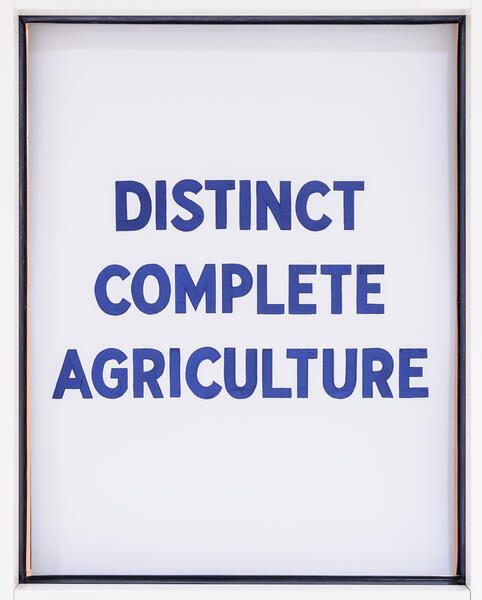 Context PostersInstallation of 192 word paintings. Materials: paper, paint, pins, wall. The one hundred and ninety-two Context Posters were derived from using a linguistic research database that allowed me to selectively search for words within popular texts published between the years 1890 and 1910. Within the database, I would look up a specific word, such as “Work”, and then ask the database to list for me the most used words written on either side of the word “Work” within those popular texts. From this list, I derived the three word concatenated poems that I hand-painted on each poster. Twelve words were searched: Power, Share, Work, Progress, Listen, Science, Labor, Sweat, Salt, Exchange, Health, and Waste. The Context Posters were part of the exhibition titled, Olivia Robinson: 1899-1902.
Context PostersInstallation of 192 word paintings. Materials: paper, paint, pins, wall. The one hundred and ninety-two Context Posters were derived from using a linguistic research database that allowed me to selectively search for words within popular texts published between the years 1890 and 1910. Within the database, I would look up a specific word, such as “Work”, and then ask the database to list for me the most used words written on either side of the word “Work” within those popular texts. From this list, I derived the three word concatenated poems that I hand-painted on each poster. Twelve words were searched: Power, Share, Work, Progress, Listen, Science, Labor, Sweat, Salt, Exchange, Health, and Waste. The Context Posters were part of the exhibition titled, Olivia Robinson: 1899-1902. -
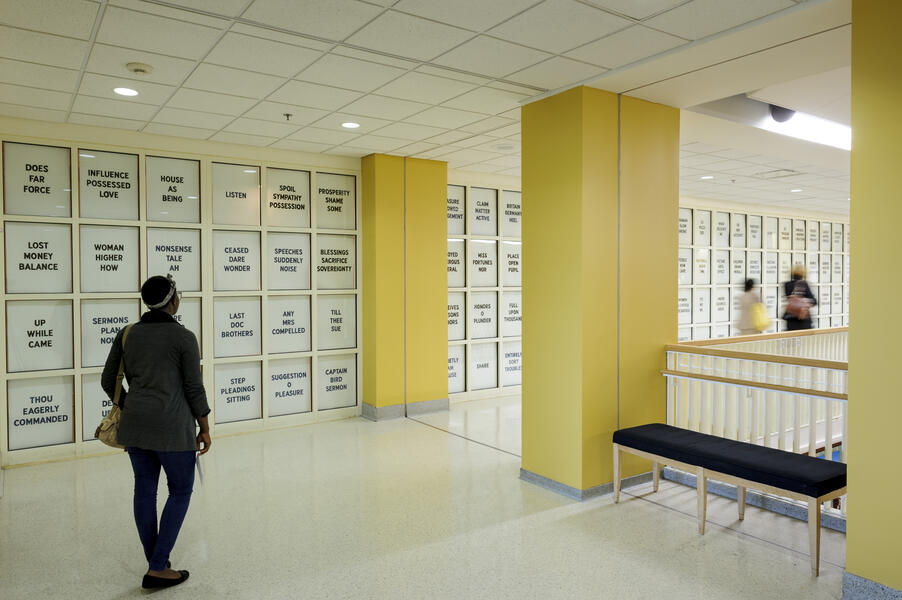 Context PostersInstallation of 192 word paintings. Materials: paper, paint, pins, wall. The one hundred and ninety-two Context Posters were derived from using a linguistic research database that allowed me to selectively search for words within popular texts published between the years 1890 and 1910. Within the database, I would look up a specific word, such as “Work”, and then ask the database to list for me the most used words written on either side of the word “Work” within those popular texts. From this list, I derived the three word concatenated poems that I hand-painted on each poster. Twelve words were searched: Power, Share, Work, Progress, Listen, Science, Labor, Sweat, Salt, Exchange, Health, and Waste. The Context Posters were part of the exhibition titled, Olivia Robinson: 1899-1902.
Context PostersInstallation of 192 word paintings. Materials: paper, paint, pins, wall. The one hundred and ninety-two Context Posters were derived from using a linguistic research database that allowed me to selectively search for words within popular texts published between the years 1890 and 1910. Within the database, I would look up a specific word, such as “Work”, and then ask the database to list for me the most used words written on either side of the word “Work” within those popular texts. From this list, I derived the three word concatenated poems that I hand-painted on each poster. Twelve words were searched: Power, Share, Work, Progress, Listen, Science, Labor, Sweat, Salt, Exchange, Health, and Waste. The Context Posters were part of the exhibition titled, Olivia Robinson: 1899-1902. -
 Context PostersInstallation of 192 word paintings. Materials: paper, paint, pins, wall. The one hundred and ninety-two Context Posters were derived from using a linguistic research database that allowed me to selectively search for words within popular texts published between the years 1890 and 1910. Within the database, I would look up a specific word, such as “Work”, and then ask the database to list for me the most used words written on either side of the word “Work” within those popular texts. From this list, I derived the three word concatenated poems that I hand-painted on each poster. Twelve words were searched: Power, Share, Work, Progress, Listen, Science, Labor, Sweat, Salt, Exchange, Health, and Waste. The Context Posters were part of the exhibition titled, Olivia Robinson: 1899-1902.
Context PostersInstallation of 192 word paintings. Materials: paper, paint, pins, wall. The one hundred and ninety-two Context Posters were derived from using a linguistic research database that allowed me to selectively search for words within popular texts published between the years 1890 and 1910. Within the database, I would look up a specific word, such as “Work”, and then ask the database to list for me the most used words written on either side of the word “Work” within those popular texts. From this list, I derived the three word concatenated poems that I hand-painted on each poster. Twelve words were searched: Power, Share, Work, Progress, Listen, Science, Labor, Sweat, Salt, Exchange, Health, and Waste. The Context Posters were part of the exhibition titled, Olivia Robinson: 1899-1902.
Nabat: Looking Back
This ever-so-slowly changing video is a record of a woman creating salt. Salt accumulates on the surface of her skin as she sits over a period of 16 minutes. Ultimately she is completely covered in rock salt. Salt is electrolyte used in the sweat batteries that power the Alchemy & Meditations piece. The video is projected into a physical frame on the wall. In the installation a fully functional sales cart for peddling human sweat sits opposite the projected video.
Nabat: Looking Back as was part of the exhibition titled, Olivia Robinson: 1899-1902. This exhibition examines a period of time now known as the “Technological Revolution.” Also known as the “Second Industrial Revolution,” this time period brought forth the internal combustion engine, new materials and substances (including alloys and chemicals), new communication technologies such as the telegraph and radio, and major advances in the use of electricity. The socioeconomic effects of these innovations would result in a radical shifting of social power structures that had been in place for centuries.
The work presented here spans a variety of media – painting, sculpture, photography, video, and electronic textiles. In the windows of the Stamp Gallery a series of 192 paintings deconstruct the language of the 19th century, grouping together words according to their most common coexistence in printed materials. A fully functional sales cart for peddling human sweat sits opposite a video of a woman demonstrating an unusual capacity for producing salt. A pew invites viewers to look upon a dramatic polyptych of thirteen electronic textile pieces. In all of these works, the time period of the Technological Revolution is used as a framework to explore issues of power, both scientific and social, and to reflect on how those issues continue to exist and evolve today.
Nabat: Looking Back as was part of the exhibition titled, Olivia Robinson: 1899-1902. This exhibition examines a period of time now known as the “Technological Revolution.” Also known as the “Second Industrial Revolution,” this time period brought forth the internal combustion engine, new materials and substances (including alloys and chemicals), new communication technologies such as the telegraph and radio, and major advances in the use of electricity. The socioeconomic effects of these innovations would result in a radical shifting of social power structures that had been in place for centuries.
The work presented here spans a variety of media – painting, sculpture, photography, video, and electronic textiles. In the windows of the Stamp Gallery a series of 192 paintings deconstruct the language of the 19th century, grouping together words according to their most common coexistence in printed materials. A fully functional sales cart for peddling human sweat sits opposite a video of a woman demonstrating an unusual capacity for producing salt. A pew invites viewers to look upon a dramatic polyptych of thirteen electronic textile pieces. In all of these works, the time period of the Technological Revolution is used as a framework to explore issues of power, both scientific and social, and to reflect on how those issues continue to exist and evolve today.
-
 First and last frame of Nabat: Looking BackThis image is of the first and last frame of the 16 minute video. This ever-so-slowly changing video is a record of a woman creating salt. Salt accumulates on the surface of her skin as she sits over a period of 16 minutes. Ultimately she is completely covered in rock salt. Salt is electrolyte used in the sweat batteries that power the Alchemy & Meditations piece. The video is projected into a physical frame on the wall. In the installation a fully functional sales cart for peddling human sweat sits opposite the projected video. Nabat: Looking Back as was part of the exhibition titled, Olivia Robinson: 1899-1902.
First and last frame of Nabat: Looking BackThis image is of the first and last frame of the 16 minute video. This ever-so-slowly changing video is a record of a woman creating salt. Salt accumulates on the surface of her skin as she sits over a period of 16 minutes. Ultimately she is completely covered in rock salt. Salt is electrolyte used in the sweat batteries that power the Alchemy & Meditations piece. The video is projected into a physical frame on the wall. In the installation a fully functional sales cart for peddling human sweat sits opposite the projected video. Nabat: Looking Back as was part of the exhibition titled, Olivia Robinson: 1899-1902. -
 Installation view of Nabat: Looking BackThis ever-so-slowly changing video is a record of a woman creating salt. Salt accumulates on the surface of her skin as she sits over a period of 16 minutes. Ultimately she is completely covered in rock salt. Salt is electrolyte used in the sweat batteries that power the Alchemy & Meditations piece. The video is projected into a physical frame on the wall. In the installation a fully functional sales cart for peddling human sweat sits opposite the projected video. Nabat: Looking Back as was part of the exhibition titled, Olivia Robinson: 1899-1902.
Installation view of Nabat: Looking BackThis ever-so-slowly changing video is a record of a woman creating salt. Salt accumulates on the surface of her skin as she sits over a period of 16 minutes. Ultimately she is completely covered in rock salt. Salt is electrolyte used in the sweat batteries that power the Alchemy & Meditations piece. The video is projected into a physical frame on the wall. In the installation a fully functional sales cart for peddling human sweat sits opposite the projected video. Nabat: Looking Back as was part of the exhibition titled, Olivia Robinson: 1899-1902. -
Nabat: Looking BackThis ever-so-slowly changing video is a record of a woman creating salt. Salt accumulates on the surface of her skin as she sits over a period of 16 minutes. Ultimately she is completely covered in rock salt. Salt is electrolyte used in the sweat batteries that power the Alchemy & Meditations piece. The video is projected into a physical frame on the wall. In the installation a fully functional sales cart for peddling human sweat sits opposite the projected video. Nabat: Looking Back as was part of the exhibition titled, Olivia Robinson: 1899-1902.
-
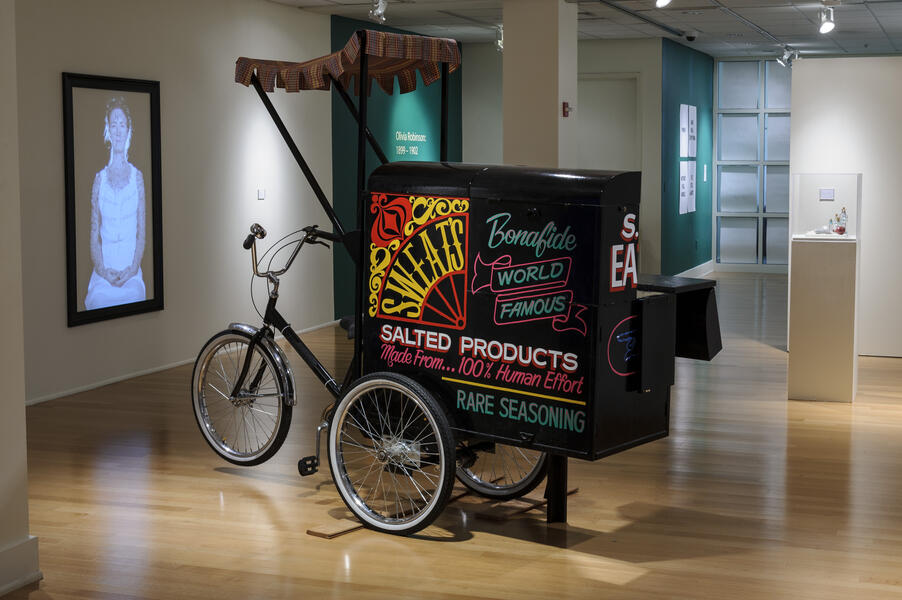 Installation view of Nabat: Looking BackThis ever-so-slowly changing video is a record of a woman creating salt. Salt accumulates on the surface of her skin as she sits over a period of 16 minutes. Ultimately she is completely covered in rock salt. Salt is electrolyte used in the sweat batteries that power the Alchemy & Meditations piece. The video is projected into a physical frame on the wall. In the installation a fully functional sales cart for peddling human sweat sits opposite the projected video. Nabat: Looking Back as was part of the exhibition titled, Olivia Robinson: 1899-1902.
Installation view of Nabat: Looking BackThis ever-so-slowly changing video is a record of a woman creating salt. Salt accumulates on the surface of her skin as she sits over a period of 16 minutes. Ultimately she is completely covered in rock salt. Salt is electrolyte used in the sweat batteries that power the Alchemy & Meditations piece. The video is projected into a physical frame on the wall. In the installation a fully functional sales cart for peddling human sweat sits opposite the projected video. Nabat: Looking Back as was part of the exhibition titled, Olivia Robinson: 1899-1902.
S. W. Eat's Salt Products Wagon
This cart is a reproduction of the one used by S.W.Eat used to peddle and sell her salted products between the years of 1899 and 1902. Prior to this time, she sold her salts from a hand-held basket, and after this time it is unknown her whereabouts. Her salts were highly sought after, and were made by distilling the salts out of sweat, an abundant by product of most labor at that time. S. W. Eat was born in 1873 as Samantha Wilhelmina Eadelsberg.
S.W.Eat's Salt Products Wagon were part of the exhibition titled, Olivia Robinson: 1899-1902. This exhibition examines a period of time now known as the “Technological Revolution.” Also known as the “Second Industrial Revolution,” this time period brought forth the internal combustion engine, new materials and substances (including alloys and chemicals), new communication technologies such as the telegraph and radio, and major advances in the use of electricity. The socioeconomic effects of these innovations would result in a radical shifting of social power structures that had been in place for centuries.
The work presented here spans a variety of media – painting, sculpture, photography, video, and electronic textiles. In the windows of the Stamp Gallery a series of 192 paintings deconstruct the language of the 19th century, grouping together words according to their most common coexistence in printed materials. A fully functional sales cart for peddling human sweat sits opposite a video of a woman demonstrating an unusual capacity for producing salt. A pew invites viewers to look upon a dramatic polyptych of thirteen electronic textile pieces. In all of these works, the time period of the Technological Revolution is used as a framework to explore issues of power, both scientific and social, and to reflect on how those issues continue to exist and evolve today.
S.W.Eat's Salt Products Wagon were part of the exhibition titled, Olivia Robinson: 1899-1902. This exhibition examines a period of time now known as the “Technological Revolution.” Also known as the “Second Industrial Revolution,” this time period brought forth the internal combustion engine, new materials and substances (including alloys and chemicals), new communication technologies such as the telegraph and radio, and major advances in the use of electricity. The socioeconomic effects of these innovations would result in a radical shifting of social power structures that had been in place for centuries.
The work presented here spans a variety of media – painting, sculpture, photography, video, and electronic textiles. In the windows of the Stamp Gallery a series of 192 paintings deconstruct the language of the 19th century, grouping together words according to their most common coexistence in printed materials. A fully functional sales cart for peddling human sweat sits opposite a video of a woman demonstrating an unusual capacity for producing salt. A pew invites viewers to look upon a dramatic polyptych of thirteen electronic textile pieces. In all of these works, the time period of the Technological Revolution is used as a framework to explore issues of power, both scientific and social, and to reflect on how those issues continue to exist and evolve today.
-
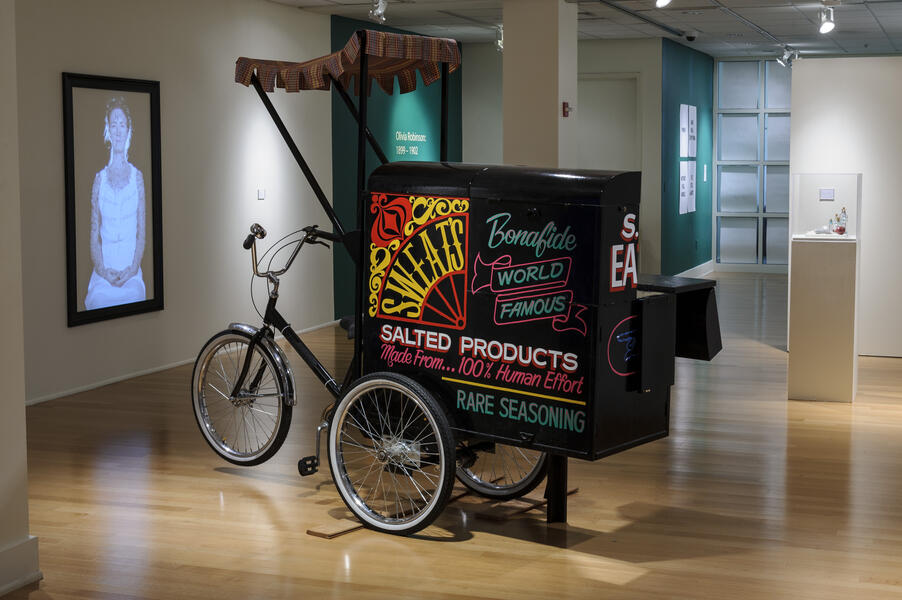 S.W.Eat's Salt Products WagonSales cart and products within exhibition. Materials: tricycle, wood, paint, fabric, bottles, and salt. This cart is a reproduction of the one that S.W.Eat used to peddle and sell her salted products between the years of 1899 and 1902. Prior to this time, she sold her salts from a hand-held basket, and after this time it is unknown her whereabouts. Her salts were highly sought after, and were made by distilling the salts out of sweat, an abundant by product of most labor at that time. S.W.Eat was born in 1873 as Samantha Wilhelmina Eadelsberg. S.W.Eat's Salt Products Wagon was part of the exhibition titled, Olivia Robinson: 1899-1902.
S.W.Eat's Salt Products WagonSales cart and products within exhibition. Materials: tricycle, wood, paint, fabric, bottles, and salt. This cart is a reproduction of the one that S.W.Eat used to peddle and sell her salted products between the years of 1899 and 1902. Prior to this time, she sold her salts from a hand-held basket, and after this time it is unknown her whereabouts. Her salts were highly sought after, and were made by distilling the salts out of sweat, an abundant by product of most labor at that time. S.W.Eat was born in 1873 as Samantha Wilhelmina Eadelsberg. S.W.Eat's Salt Products Wagon was part of the exhibition titled, Olivia Robinson: 1899-1902. -
 S.W.Eat's Salt Products WagonSales cart and products within exhibition. Materials: tricycle, wood, paint, fabric, bottles, and salt. This cart is a reproduction of the one that S.W.Eat used to peddle and sell her salted products between the years of 1899 and 1902. Prior to this time, she sold her salts from a hand-held basket, and after this time it is unknown her whereabouts. Her salts were highly sought after, and were made by distilling the salts out of sweat, an abundant by product of most labor at that time. S.W.Eat was born in 1873 as Samantha Wilhelmina Eadelsberg. S.W.Eat's Salt Products Wagon was part of the exhibition titled, Olivia Robinson: 1899-1902.
S.W.Eat's Salt Products WagonSales cart and products within exhibition. Materials: tricycle, wood, paint, fabric, bottles, and salt. This cart is a reproduction of the one that S.W.Eat used to peddle and sell her salted products between the years of 1899 and 1902. Prior to this time, she sold her salts from a hand-held basket, and after this time it is unknown her whereabouts. Her salts were highly sought after, and were made by distilling the salts out of sweat, an abundant by product of most labor at that time. S.W.Eat was born in 1873 as Samantha Wilhelmina Eadelsberg. S.W.Eat's Salt Products Wagon was part of the exhibition titled, Olivia Robinson: 1899-1902. -
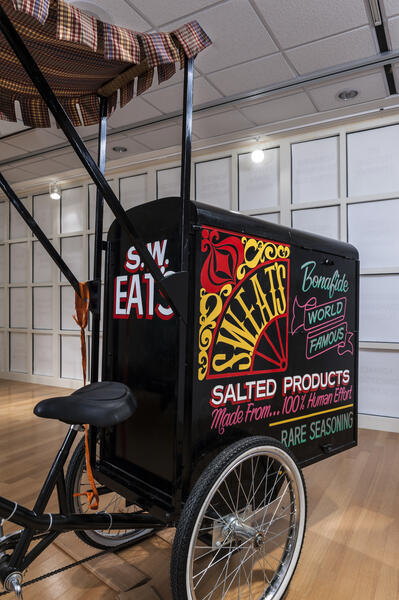 S.W.Eat's Salt Products WagonSales cart and products within exhibition. Materials: tricycle, wood, paint, fabric, bottles, and salt. This cart is a reproduction of the one that S.W.Eat used to peddle and sell her salted products between the years of 1899 and 1902. Prior to this time, she sold her salts from a hand-held basket, and after this time it is unknown her whereabouts. Her salts were highly sought after, and were made by distilling the salts out of sweat, an abundant by product of most labor at that time. S.W.Eat was born in 1873 as Samantha Wilhelmina Eadelsberg. S.W.Eat's Salt Products Wagon was part of the exhibition titled, Olivia Robinson: 1899-1902.
S.W.Eat's Salt Products WagonSales cart and products within exhibition. Materials: tricycle, wood, paint, fabric, bottles, and salt. This cart is a reproduction of the one that S.W.Eat used to peddle and sell her salted products between the years of 1899 and 1902. Prior to this time, she sold her salts from a hand-held basket, and after this time it is unknown her whereabouts. Her salts were highly sought after, and were made by distilling the salts out of sweat, an abundant by product of most labor at that time. S.W.Eat was born in 1873 as Samantha Wilhelmina Eadelsberg. S.W.Eat's Salt Products Wagon was part of the exhibition titled, Olivia Robinson: 1899-1902. -
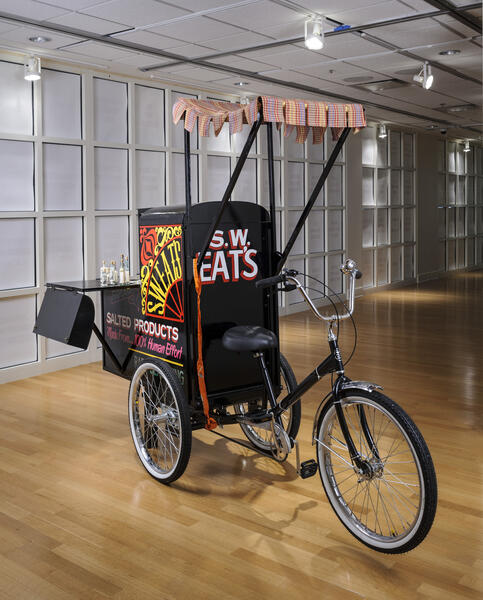 S.W.Eat's Salt Products WagonSales cart and products within exhibition. Materials: tricycle, wood, paint, fabric, bottles, and salt. This cart is a reproduction of the one that S.W.Eat used to peddle and sell her salted products between the years of 1899 and 1902. Prior to this time, she sold her salts from a hand-held basket, and after this time it is unknown her whereabouts. Her salts were highly sought after, and were made by distilling the salts out of sweat, an abundant by product of most labor at that time. S.W.Eat was born in 1873 as Samantha Wilhelmina Eadelsberg. S.W.Eat's Salt Products Wagon was part of the exhibition titled, Olivia Robinson: 1899-1902.
S.W.Eat's Salt Products WagonSales cart and products within exhibition. Materials: tricycle, wood, paint, fabric, bottles, and salt. This cart is a reproduction of the one that S.W.Eat used to peddle and sell her salted products between the years of 1899 and 1902. Prior to this time, she sold her salts from a hand-held basket, and after this time it is unknown her whereabouts. Her salts were highly sought after, and were made by distilling the salts out of sweat, an abundant by product of most labor at that time. S.W.Eat was born in 1873 as Samantha Wilhelmina Eadelsberg. S.W.Eat's Salt Products Wagon was part of the exhibition titled, Olivia Robinson: 1899-1902. -
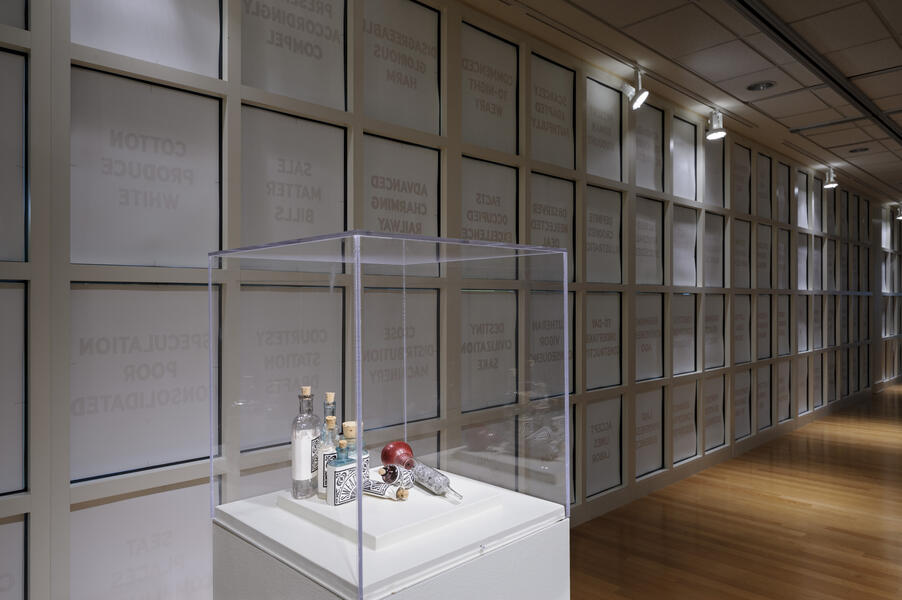 S.W.Eat's Salted ProductsSalt products within exhibition. Materials: bottles, paper and salt. S.W.Eat's Salt Products were part of the exhibition titled, Olivia Robinson: 1899-1902.
S.W.Eat's Salted ProductsSalt products within exhibition. Materials: bottles, paper and salt. S.W.Eat's Salt Products were part of the exhibition titled, Olivia Robinson: 1899-1902. -
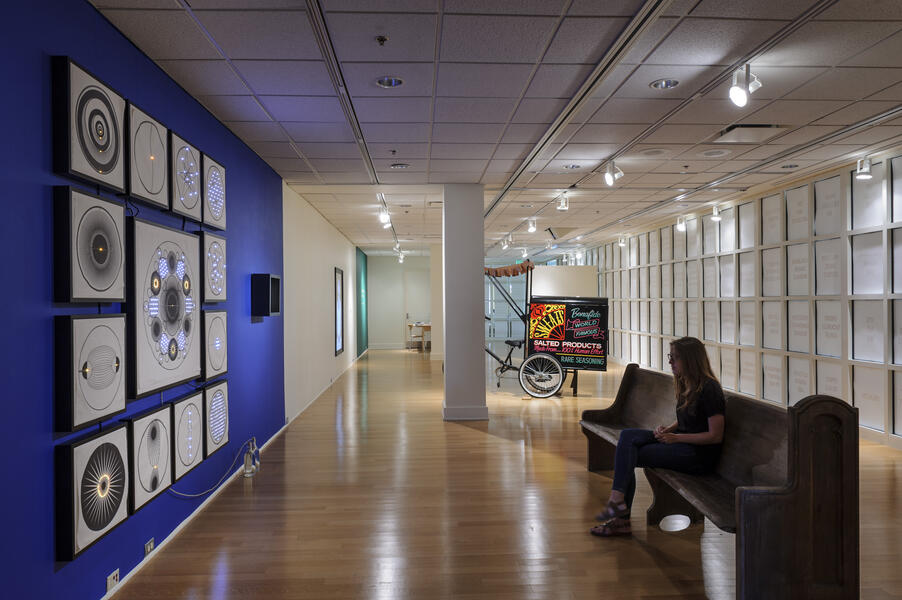 Exhibition viewSales cart and products within exhibition. Materials: tricycle, wood, paint, fabric, bottles, and salt. This cart is a reproduction of the one used by S.W.Eat used to peddle and sell her salted products between the years of 1899 and 1902. Prior to this time, she sold her salts from a hand-held basket, and after this time it is unknown her whereabouts. Her salts were highly sought after, and were made by distilling the salts out of sweat, an abundant by product of most labor at that time. S.W.Eat was born in 1873 as Samantha Wilhelmina Eadelsberg. S.W.Eat's Salt Products Wagon were part of the exhibition titled, Olivia Robinson: 1899-1902.
Exhibition viewSales cart and products within exhibition. Materials: tricycle, wood, paint, fabric, bottles, and salt. This cart is a reproduction of the one used by S.W.Eat used to peddle and sell her salted products between the years of 1899 and 1902. Prior to this time, she sold her salts from a hand-held basket, and after this time it is unknown her whereabouts. Her salts were highly sought after, and were made by distilling the salts out of sweat, an abundant by product of most labor at that time. S.W.Eat was born in 1873 as Samantha Wilhelmina Eadelsberg. S.W.Eat's Salt Products Wagon were part of the exhibition titled, Olivia Robinson: 1899-1902.
Alchemy and Meditations
The thirteen Alchemy & Meditations pieces are made from conductive and non-conductive textiles and LED lights. The imagery is based upon 19th century ideas about alchemy and electrical energy, combined with 21st century ideas of meditation. A series of batteries made using sweat, sit near the pieces as if powering the electronic textiles.
Alchemy & Meditations were part of an exhibition titled, Olivia Robinson: 1899-1902. This exhibition examines a period of time now known as the “Technological Revolution.” Also known as the “Second Industrial Revolution,” this time period brought forth the internal combustion engine, new materials and substances (including alloys and chemicals), new communication technologies such as the telegraph and radio, and major advances in the use of electricity. The socioeconomic effects of these innovations would result in a radical shifting of social power structures that had been in place for centuries.
The work presented here spans a variety of media – painting, sculpture, photography, video, and electronic textiles. In the windows of the Stamp Gallery a series of 192 paintings deconstruct the language of the 19th century, grouping together words according to their most common coexistence in printed materials. A fully functional sales cart for peddling human sweat sits opposite a video of a woman demonstrating an unusual capacity for producing salt. A pew invites viewers to look upon a dramatic polyptych of thirteen electronic textile pieces. In all of these works, the time period of the Technological Revolution is used as a framework to explore issues of power, both scientific and social, and to reflect on how those issues continue to exist and evolve today.
Alchemy & Meditations were part of an exhibition titled, Olivia Robinson: 1899-1902. This exhibition examines a period of time now known as the “Technological Revolution.” Also known as the “Second Industrial Revolution,” this time period brought forth the internal combustion engine, new materials and substances (including alloys and chemicals), new communication technologies such as the telegraph and radio, and major advances in the use of electricity. The socioeconomic effects of these innovations would result in a radical shifting of social power structures that had been in place for centuries.
The work presented here spans a variety of media – painting, sculpture, photography, video, and electronic textiles. In the windows of the Stamp Gallery a series of 192 paintings deconstruct the language of the 19th century, grouping together words according to their most common coexistence in printed materials. A fully functional sales cart for peddling human sweat sits opposite a video of a woman demonstrating an unusual capacity for producing salt. A pew invites viewers to look upon a dramatic polyptych of thirteen electronic textile pieces. In all of these works, the time period of the Technological Revolution is used as a framework to explore issues of power, both scientific and social, and to reflect on how those issues continue to exist and evolve today.
-
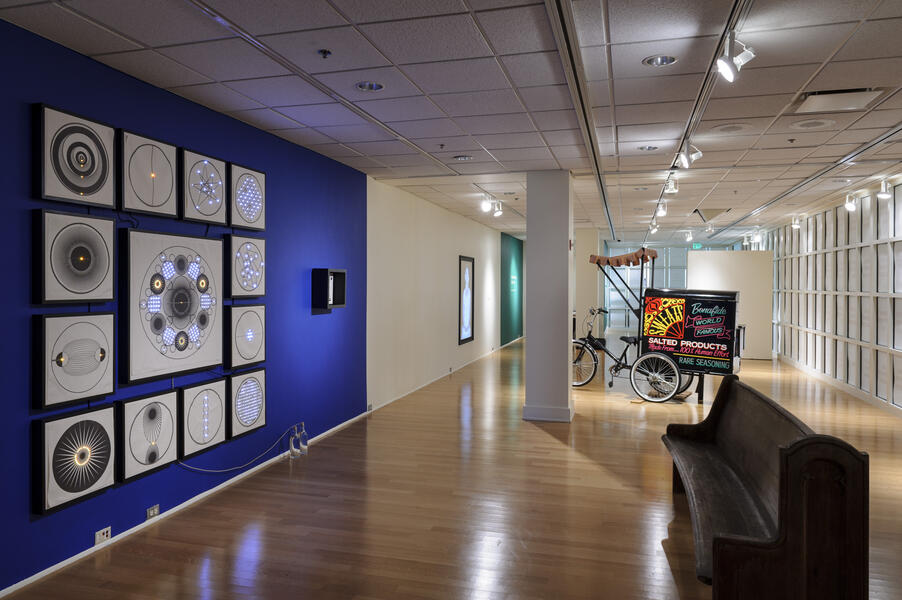 Alchemy and MeditationsInstallation view of recent exhibition including the Alchemy and Meditation series. The exhibition included four different, though related, works: Alchemy and Meditation, S.W.Eat's Salt Product Wagon, Nabat: Looking Back, and Context Posters. The exhibition was titled, Olivia Robinson: 1899-1902.
Alchemy and MeditationsInstallation view of recent exhibition including the Alchemy and Meditation series. The exhibition included four different, though related, works: Alchemy and Meditation, S.W.Eat's Salt Product Wagon, Nabat: Looking Back, and Context Posters. The exhibition was titled, Olivia Robinson: 1899-1902. -
 Empathy (part of Alchemy and Meditation Series)Electronic textile. Materials: cotton muslin, copper taffeta, LEDs, silver thread, wire, wood, metal buttons, electricity. The thirteen Alchemy & Meditations pieces are made from conductive and non-conductive textiles and LED lights. The imagery is based upon 19th century ideas about alchemy and electrical energy, combined with 21st century ideas of meditation. A series of batteries made using sweat, sit near the pieces as if powering the electronic textiles.
Empathy (part of Alchemy and Meditation Series)Electronic textile. Materials: cotton muslin, copper taffeta, LEDs, silver thread, wire, wood, metal buttons, electricity. The thirteen Alchemy & Meditations pieces are made from conductive and non-conductive textiles and LED lights. The imagery is based upon 19th century ideas about alchemy and electrical energy, combined with 21st century ideas of meditation. A series of batteries made using sweat, sit near the pieces as if powering the electronic textiles. -
 Intention (part of Alchemy and Meditation Series)Electronic textile. Materials: cotton muslin, copper taffeta, LEDs, silver thread, wire, wood, electricity. The thirteen Alchemy & Meditations pieces are made from conductive and non-conductive textiles and LED lights. The imagery is based upon 19th century ideas about alchemy and electrical energy, combined with 21st century ideas of meditation. A series of batteries made using sweat, sit near the pieces as if powering the electronic textiles.
Intention (part of Alchemy and Meditation Series)Electronic textile. Materials: cotton muslin, copper taffeta, LEDs, silver thread, wire, wood, electricity. The thirteen Alchemy & Meditations pieces are made from conductive and non-conductive textiles and LED lights. The imagery is based upon 19th century ideas about alchemy and electrical energy, combined with 21st century ideas of meditation. A series of batteries made using sweat, sit near the pieces as if powering the electronic textiles. -
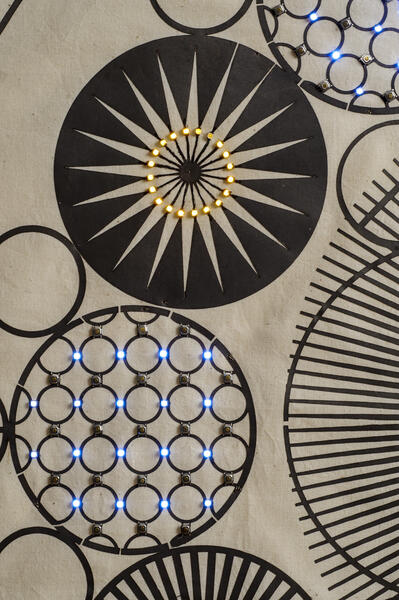 Detail of Alchemy and Meditation SeriesElectronic textile. Materials: cotton muslin, copper taffeta, LEDs, silver thread, wire, wood, metal buttons, electricity. The thirteen Alchemy & Meditations pieces are made from conductive and non-conductive textiles and LED lights. The imagery is based upon 19th century ideas about alchemy and electrical energy, combined with 21st century ideas of meditation. A series of batteries made using sweat, sit near the pieces as if powering the electronic textiles.
Detail of Alchemy and Meditation SeriesElectronic textile. Materials: cotton muslin, copper taffeta, LEDs, silver thread, wire, wood, metal buttons, electricity. The thirteen Alchemy & Meditations pieces are made from conductive and non-conductive textiles and LED lights. The imagery is based upon 19th century ideas about alchemy and electrical energy, combined with 21st century ideas of meditation. A series of batteries made using sweat, sit near the pieces as if powering the electronic textiles. -
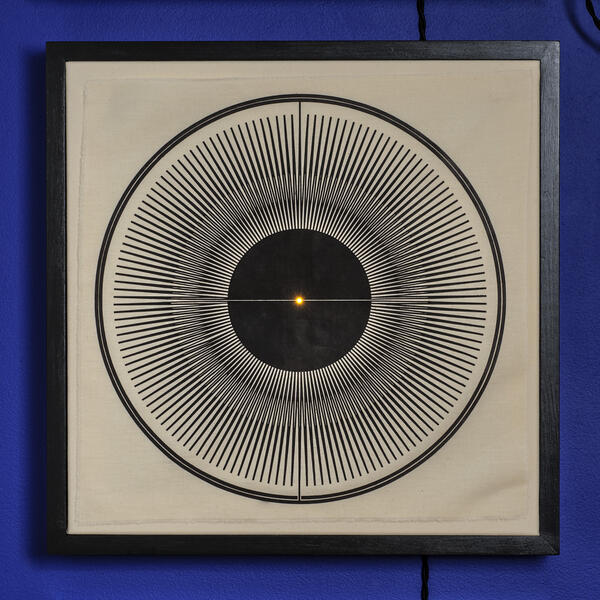 Observation (part of Alchemy and Meditation Series)Electronic textile. Materials: cotton muslin, copper taffeta, LEDs, silver thread, wire, wood, electricity. The thirteen Alchemy & Meditations pieces are made from conductive and non-conductive textiles and LED lights. The imagery is based upon 19th century ideas about alchemy and electrical energy, combined with 21st century ideas of meditation. A series of batteries made using sweat, sit near the pieces as if powering the electronic textiles.
Observation (part of Alchemy and Meditation Series)Electronic textile. Materials: cotton muslin, copper taffeta, LEDs, silver thread, wire, wood, electricity. The thirteen Alchemy & Meditations pieces are made from conductive and non-conductive textiles and LED lights. The imagery is based upon 19th century ideas about alchemy and electrical energy, combined with 21st century ideas of meditation. A series of batteries made using sweat, sit near the pieces as if powering the electronic textiles. -
 Alchemy and MeditationsElectronic textile polyptych. Materials: cotton muslin, copper taffeta, LEDs, silver thread, wire, wood, metal buttons, electricity and wooden bench. The thirteen Alchemy & Meditations pieces are made from conductive and non-conductive textiles and LED lights. The imagery is based upon 19th century ideas about alchemy and electrical energy, combined with 21st century ideas of meditation. A series of batteries made using sweat, sit near the pieces as if powering the electronic textiles.
Alchemy and MeditationsElectronic textile polyptych. Materials: cotton muslin, copper taffeta, LEDs, silver thread, wire, wood, metal buttons, electricity and wooden bench. The thirteen Alchemy & Meditations pieces are made from conductive and non-conductive textiles and LED lights. The imagery is based upon 19th century ideas about alchemy and electrical energy, combined with 21st century ideas of meditation. A series of batteries made using sweat, sit near the pieces as if powering the electronic textiles. -
 Alchemy and MeditationsElectronic textile polyptych. Materials: cotton muslin, copper taffeta, LEDs, silver thread, wire, wood, metal buttons, electricity. The thirteen Alchemy & Meditations pieces are made from conductive and non-conductive textiles and LED lights. The imagery is based upon 19th century ideas about alchemy and electrical energy, combined with 21st century ideas of meditation. A series of batteries made using sweat, sit near the pieces as if powering the electronic textiles.
Alchemy and MeditationsElectronic textile polyptych. Materials: cotton muslin, copper taffeta, LEDs, silver thread, wire, wood, metal buttons, electricity. The thirteen Alchemy & Meditations pieces are made from conductive and non-conductive textiles and LED lights. The imagery is based upon 19th century ideas about alchemy and electrical energy, combined with 21st century ideas of meditation. A series of batteries made using sweat, sit near the pieces as if powering the electronic textiles.

